Preprint
Article
Analysis of the Thermal and Catalytic Pyrolysis Process in the Regions of the Municipality of Belém Based on Socio-economic Classification
This version is not peer-reviewed.


















Submitted:
18 October 2024
Posted:
21 October 2024
You are already at the latest version
Abstract
This work aims to evaluate the by-products obtained by thermal and catalytic pyroly-sis of the fraction (organic matter and paper) of municipal solid waste (MSW), in dif-ferent socioeconomic regions, through the yields of reaction products (bio-oil, bio-char, H2O and gas), acid value and chemical composition of bio-oils, and characteriza-tion of biochar, on a laboratory scale. The organic matter and paper segregated from the gravimetric composition of the total waste sample were subjected to drying, crushing and sieving pre-treatment. The experiments were carried out at 450 °C and 1.0 atmosphere, and at 400 °C and 475 °C and 1.0 atmosphere, using 10.0% (by mass) of the basic catalyst Ca(OH)2, in discontinuous mode. The bio-oil was characterized by acidity value and the chemical functions present in the bio-oil identified by FT-IR, NMR and composition by GC-MS. The biochar was characterized by SEM/EDS and XRD. The bio-oil yield increased with the addition of catalyst and the pyrolysis tem-perature. For catalytic pyrolysis, bio-char and gas yields increased slightly with Ca(OH)2 content, while bio-oil and H2O phase remained constant. GC-MS of the liquid reaction products identified the presence of hydrocarbons and oxygenates, as well as nitrogen-containing compounds, including amides and amines. The acidity of the bio-oil decreased with the addition of the basic catalyst in the process. The concentration of hydrocarbons in the bio-oil appeared with the addition of the catalyst in the catalyt-ic pyrolysis process as catalytic deoxygenation of fatty acid molecules occurs, through decarboxylation/decarbonylation, producing aliphatic and aromatic hydrocarbons, in-troducing the basic catalyst into the thermal process.
Keywords:
Subject:
Engineering - Civil Engineering1. Introduction
The generation of solid waste is directly related to the way of life, population growth and consumption patterns and is, without a doubt, one of the greatest challenges that governments have faced. According to [1], in 2011, cities around the world generated 1.3 billion tons of solid waste annually, a volume that is expected to reach 2.2 billion tons by 2025. It is estimated that municipalities that are part of developing countries currently spend 20 to 50% of their budgets on the management and disposal of solid waste, with little or no value derived from them [2].
The impacts of unmanaged urban solid waste go beyond cities, affecting ecosystems such as the oceans, where millions of tons of plastic were discarded in 2010, according to [3]. In 2022, Brazil generated 77.1 million tons of urban solid waste (MSW), collecting 71.72 million tons. Of these, 43.8 million were sent to landfills, and 27.97 million were inappropriately disposed of. Recycling activities processed 1.12 million tons, and composting 127.5 thousand tons, but these numbers are still insufficient compared to other countries, resulting in significant financial losses for the efficient management of MSW.
In 2021, the Northern Region of Brazil generated around 35.8% (approximately 1,773,927 tons/year) of Municipal Solid Waste (MSW) with adequate disposal, while 64.4% (around 3,209,013 tons/year) year) were allocated inappropriately [4]. A gradual increase in the amount of solid waste leads to several problems in transporting, storing and disposing of this waste and makes efficient solid waste management complicated [5]. According to Sustainable Development Goal 11 (SDG 11) [6], adequate management of urban waste is critically significant for advancing sustainability and ensuring the preservation of natural resources for future generations [7].
MSW has great economic potential [8] and the efficiency of waste management systems affects the potential economic value of MSW. Solid waste is heterogeneous and may be made up of elements that are difficult to degrade/treat and assimilate into the environment, causing risks to environmental protection and consequences for public health [9,10]. However, until adequate disposal and treatment of solid waste is given, other steps are necessary, following applicable guidelines through the development of solid waste management systems [11]. To implement an efficient integrated MSW system, it is necessary to know the per capita generation and its gravimetric composition, which has attracted the attention of researchers in recent years such as [12,13,14], who are focused on the sectorization of waste collection routes, gravimetric characterization and energy valuation of the technological route for MSW treatment [5].
Several research indicate that the generation of urban solid waste (MSW) is influenced by socioeconomic class, as per studies by the authors [15,16,17]. Higher class regions produce more waste, with greater diversity and quantity of recyclable materials, while lower class areas generate less waste, with organic materials predominating. Waste disposal and treatment are more efficient in higher-income regions, while inadequate management in lower-income areas can worsen environmental and public health problems [18,19].
Carneiro [20] stood out as one of the pioneers in exploring the economic potential of MSW generated in the municipalities of Belém, which will host COP 30 in 2025, and Ananindeua in the state of Pará/Brazil. Their research allowed the identification of an average change of 13% in the amount of recycled material between 2000 and 2006, influenced by the social profile of the population Silva et al. [12]. These significant contributions provide valuable insights for the development of comprehensive strategies in integrated MSW management, considering economic, environmental and social aspects [21]. Due to the problems associated with the treatment and final disposal of solid waste, alternatives and proposals have been studied and applied in several countries. Among the alternatives are thermochemical technologies that involve the treatment of MSW before they are disposed of in landfills, and are divided into three technologies, combustion, gasification and pyrolysis. Among them, pyrolysis is a process of thermal conversion of biomass into energy, where in an inert environment, the possibility of producing chemical species and products with greater added value, make this process an attractive option given current initiatives in the search for new sources of renewable energy. It can be defined as the process of thermal decomposition of biomass in the absence of oxygen, in the presence (catalytic) or absence of catalyst (thermal) and has the capacity to convert MSW into three by-products, namely, organic fraction (bio-oil and water), biochar (biochar) and biogas (non-condensable gases) [22,23,24,25,26]. The proportions of by-products depend on the type of pyrolysis used which, in turn, varies according to the operational process variables used such as reaction temperature, heating rate and residence time of vapors inside the reactor. [27].
The main objective of MSW pyrolysis is to recover energy, since the products resulting from a pyrolysis process have, in most cases, properties similar to those of fuels. The pyrolysis process has the potential to convert municipal solid waste (MSW) into a usable source of energy for homes, as pointed out by [28]. Furthermore, the energy products generated during pyrolysis can be used to optimize the operational efficiency of larger-scale plants that use this technology.
The composition and properties of oils and biochars obtained through pyrolysis can make them suitable as raw materials for various industrial sectors. Considering the heterogeneous nature of municipal solid waste (MSW) and the variation in its composition according to location, this section offers a brief overview of the products resulting from MSW pyrolysis. This also allows you to distinguish between the different types of products generated by the process. MSW contains a significant proportion of organic waste, mainly composed of food waste, wood and garden waste. Food waste contains several carbon-rich substances, which makes it a valuable source for fuel production [29].
The pyrolysis of different types of organic waste has been widely studied and documented in the literature by several researchers, including [30,31,32,33,34,35,36]. Furthermore, other studies have specifically focused on the pyrolysis of solid waste, such as paper fraction, as investigated by [37,38,39,40,41,42,43,44,45,46]. Municipal solid waste generated in homes is generally stored in a single location. In many cases, municipal authorities carry out collection without separating the different components present in MSW. Therefore, it is essential to develop a pyrolysis process capable of treating mixed MSW. Wastes whose composition resembles the organic fraction are the most suitable for pyrolysis experiments, contributing to a better understanding of the real composition and yield of the products generated. Due to the complexity of this organic fraction, most pyrolysis studies have focused on individual components. However, MSW components do not act independently during the pyrolysis process, making it crucial to examine the actual behavior of mixed MSW. Several researchers have studied the pyrolysis of MSW, combining several fractions to better understand this behavior, among them [47,48,49,50,51,52,53,54,55].
Some authors have investigated pyrolysis and thermal-catalytic cracking of MSW, such as flash pyrolysis [56,57,58,59], as well as fixed bed reactors [50,60,61,62,63,66,67], and fluidized bed reactors [64], and experiments were carried out on micro [70], laboratory [57,58,59,65,66,67,68,71,72] and pilot [60]. The largest number of research studies on catalysts focuses on zeolites [69], which are acid catalysts, they form products mainly in the gasoline range, as seen in [70]. The basic ones are widely used in reactions to obtain biofuels due to the high levels of conversion achieved in this process, with most molecules remaining in the boiling range of diesel fuel, allowing reaction rates to be obtained higher than those obtained with the same number of catalysts in the acid process [71]. Among the basic catalysts used in the pyrolysis of MSW fractions are CaO studies [58]; calcined calcite (CaO) [59], calcium hydroxide CaOH2 [80] and calcined dolomite (MgO.CaO) [59,72].
It is important to highlight that catalytic pyrolysis is one of the most important processes in the refining industry, especially when it comes to the process of obtaining better quality gasoline and higher octane (through the optimization of aromatic and olefin contents [22,23,24,25,26]. To date, no research has investigated the effect of temperature and percentage of CaOH2-type catalyst for the MSW fraction (organic matter and paper) and its implications on the morphology of biochar. and in the crystalline structure, as well as in the yield of reaction products, chemical composition and acidity of bio-oils obtained by pyrolysis and catalytic pyrolysis, in different socioeconomic regions in the same municipality.
Considering the great impact caused by waste, it is essential to have a broad discussion on its treatment and destination, addressing technological, economic and environmental aspects, taking into account the various existing technological alternatives and considering, above all, regionalities. of each location, the economic valorization of materials and their energy valorization when feasible. Thus, based on the scenario presented and aiming to contribute to the development of technology to promote the sustainability of the MSW treatment sector, in summary, the work proposes to investigate an alternative use of Urban Solid Waste (MSW), through pyrolysis, with the production of materials of commercial interest, as opposed to conventional forms of disposal.
2. Materials and Methods
For the development of the research, the methodological procedures were structured in stages in order to investigate all relevant points of the proposal, according to the flowchart presented in Figure 1. The beginning of the development of the experimental research was carried out in 2021 .
This research adopted the methodology of collection, transportation, segregation, treatment and disposal of urban solid waste from research by [73,74], in which the study area defined was the 21 neighborhoods of the municipality of Belém/Pará, in which the provision of solid waste collection services is carried out by the company TERRAPLENA LTDA, responsible for Lot 1, as described in the Belém Municipal Basic Sanitation Plan [75], Figure 2. Understanding the specific context of basic sanitation conditions in this region is essential, considering that the area covers a significant part of the city and has 37 itineraries (routes), reflecting the extent of the company’s coverage in providing services related to basic sanitation, such as solid waste collection, water and sewage treatment, earthmoving, among others. This information is valuable for evaluating the efficiency and scope of sanitation services in the region, as well as for identifying challenges or areas that require improvement. Considering the socioeconomic diversity of neighborhoods is fundamental, as it directly impacts the demands and needs of the population in relation to basic sanitation services. By analyzing this distribution, it is possible to direct public policies and investments more effectively, with the aim of improving the living and health conditions of local communities. This strategic approach allows for a more precise allocation of resources, meeting the specific needs of each demographic group and promoting an equitable distribution of the benefits of basic sanitation.
To carry out a comprehensive characterization of urban solid waste (MSW) in the 21 neighborhoods served by the company TERRAPLENA LTDA, a detailed and viable work plan was developed, consisting of several stages that included quantitative and qualitative analyzes of waste. Initially, neighborhood visits were carried out to understand the waste flow and determine the volume to be collected. Then, samples of the newly deposited waste were collected and transported to specific locations, where the gravimetric composition was determined. Subsequently, the samples were prepared for detailed laboratory analysis. This comprehensive plan provided an in-depth understanding of the nature and quantity of waste in each neighborhood, establishing a solid foundation for developing future waste management strategies. During the on-site visits, considering the number of itineraries and the coverage area, as well as the economic similarity between some neighborhoods, the 37 itineraries were grouped into nine sectors (Figure 3). These sectors were defined based on socioeconomic characteristics and geographic proximity, facilitating the execution of gravimetric analysis campaigns throughout the collection and transport area operated by TERRAPLENA in the municipality of Belém.
The neighborhoods were categorized according to family income, using a methodology adapted from the IBGE guidelines [76] (Table 1). This methodology classifies the Brazilian population into five classes (A, B, C, D and E), with the minimum wage as a reference. It is worth noting that, in the municipality of Belém, there are no neighborhoods classified in classes A and B. The majority of neighborhoods, approximately 61%, are classified in class E.
With the organization of sectors, we were able to establish the formation of regions which represent larger areas. These regions were considered as units for sampling solid waste intended for laboratory analysis. Thus, we determined the composition of three regions, as shown in Table 2.
2.1. Gravimetric Composition of Urban Solid Waste
To determine the gravimetric composition of the waste, STATIDISK 13.0 software was used to calculate the required volume of samples. Considering the capacity of the collection truck (15m³ per route), a significance level of 5%, a confidence level of 95% and a margin of error of 10% were adopted. The simulation resulted in a sample mass of approximately 100 kg, ensuring accurate and reliable waste analysis. The choice of parameters reflects the concern with the statistical validity of the results, according to Assunção et al. [73].
The gravimetric analysis of solid waste was divided into fractions such as Paper, Cardboard, Tetrapak, Rigid Plastic, Malleable Plastic, Glass, Metal, Organic Matter, Textiles, Sanitary Waste and Others, being essential to understand in detail the composition of the waste generated. This method provides a more specific analysis than broad characterizations, associating each fraction with different waste sources and implications for waste management. The process begins with measuring the total mass of waste to ensure the representativeness of the sample, following a detailed methodology such as that of Assunção et al. [73].
Solid waste collection took place from November 2021 to May 2022, using the door-to-door method at various points in the city of Belém. The activities were planned to cover an extensive urban area. This method ensures that waste is collected in conditions similar to those in which it was generated, preserving its original composition, including the degree of humidity. The waste was sent to a space at the Federal University of Pará, where gravimetric characterization was carried out immediately after its arrival. In collections carried out at night, characterization took place the following morning. Collections followed the schedule of TERRAPLENA’s internal routes, being carried out on Mondays, Wednesdays and Fridays, in the morning. The sampling process was conducted in accordance with ABNT Solid Waste Sampling guidelines [77].
Samples were collected in plastic bags with a capacity of 200 kg, at random points along the route of the solid waste compactor truck, demonstrating careful planning to obtain representative data on the composition of household waste. Sampling at random points is crucial to avoid collection bias by ensuring that data reflects a variety of conditions along the route. Prioritizing residential locations contributes to capturing a wide range of household waste, essential for understanding disposal practices and guiding waste management in these contexts [78].
Subsequently, the material was transported to the Sludge and Composting experiment area at UFPA, a flat, moisture-free area of 100 m². The waste was weighed and placed on a surface waterproofed by 6 x 6 m tarpaulins. Then, the waste was segregated and manually classified into different fractions: Paper, Cardboard, Tetrapak, Rigid Plastic, Malleable Plastic, Glass, Metal, Organic Matter, Fabrics, Sanitary Waste and Rejects/Others. Each fraction was weighed using a digital scale (Welmy, São Paulo-Brazil, Model: W200/50).
Pré-Tratamento das Amostras e Determinações Laboratoriais
Municipal solid waste (MSW), due to inadequate disposal and exposure to the environment, had a high moisture content, damaging the pyrolysis process. To remedy this, the organic fraction underwent a drying process in a thermal oven with air recirculation and analog temperature control (Model De Leo Ltd.a, 127V), at 105°C, for 24 hours. After drying, the MSW was crushed using a TRAPP TRF 600 model knife mill, using sieves of different diameters (0.8 mm for the organic fraction and 5 mm for the others). The crushed material was measured on a scale model WELMY CLASS 3 W200/S (maximum capacity of 200 kg and minimum precision of 1.0 kg). The separation of the crushed material was carried out using a PRODUTEST Telastem sifting system for analyzes LTDA. Finally, the pretreated organic fraction was stored in a freezer at 0°C to avoid physicochemical and microbiological degradation.
2.2. Experimental Procedure
2.2.1. Pyrolysis Process Experimental Apparatus
The laboratory-scale pyrolysis unit is composed of a cylindrical-shaped borosilicate reactor, with a volumetric capacity of approximately 200 ml. This reactor is inserted into a cylindrical furnace equipped with a collar-type ceramic resistance, with a power of 800 W. The resistance is connected to a digital temperature and heating rate controller (THERMA, model TH90DP202-000), which has a sensor type K temperature sensor (Ecil, model QK.2), as described in detail by Assunção et al. [73] and De Castro et al. [79]. Figures 4 illustrates the description of the pyrolysis laboratory unit.
2.2.2. Experimental procedures
In the laboratory scale investigation, thermal and catalytic pyrolysis experiments were carried out to verify the influence of variations in catalyst percentage on the yields and characteristics of the products obtained, at temperatures of 400°C, 450°C and 475°C, aiming to evaluate the influence of process parameters, yield and characteristics of the products obtained, all carried out at a heating rate of 10° C/min. Table 3 shows the experimental conditions used in the pyrolysis processes of urban solid waste (organic fraction and paper), in the absence and presence of Ca(OH)2 catalyst.
The experiments were carried out in semi-continuous mode, at temperatures of 450°C and 475°C at 1.0 atm, with 10% Ca(OH)2 catalyst, in order to evaluate the influence of this final temperature variation on the yield. and the physical-chemical characteristics of the liquid product obtained (bio-oil). The masses of the MSW fractions (organic and paper) were initially weighed on a semi-analytical balance (QUIMIS, Q—500L210C), being approximately 40 g for the thermal experiments and 30 g for the catalytic pyrolysis.
Then, the samples were placed in the 200 mL borosilicate glass reactor, which was inserted into the jacketed cylindrical furnace. Using the temperature control system, the reaction time, heating rate and final process temperature (set-point) were programmed based on Equation 3, resulting in different process times for each pre-defined temperature. A time of 10 minutes was established to keep each final operating temperature constant. The experimental apparatus was assembled by connecting the cooling condenser to the reactor, with the refrigerator fluid maintained at 20°C. From room temperature (25°C), the slow pyrolysis process began with a heating rate of 10°C/min, monitoring and collecting the operational parameters of the process, such as elevation temperature (heating ramp), time and temperature of product formation.
2.5. Physicochemical and Chemical Composition of Bio-Oil
2.5.1. Physicochemical Characterization of Bio-Oil and Aqueous Phase
2.5.2. Chemical Composition of Bio-Oil and Aqueous Phase
The chemical composition of the bio-oil and the aqueous phase were determined by GC-MS and the equipment and procedure described in detail by Almeida et al. [25], Castro et al. [79]. Concentrations were expressed in area, as no internal standard was injected to compare peak areas. Absorption spectra in the infrared (IR) region were obtained with an FTIR spectrometer (Shimadzu, Model: Prestige 21). The liquid samples were added between the KBr plates using pipettes and the plates were mounted with light pressure on the liquid, aiming to guarantee the uniformity of the film formed. The spectrum resolution was 16 cm-1 and the scanning range was 400 to 4000 cm-1. NMR spectra were obtained on a VARIAN spectrometer (model UNITY 300, 300 MHz), using deuterated chloroform as solvent and TMS as internal reference. To acquire hydrogen data, the following parameters were used: number of transients (nt) 128, pulse width (pw) 7.16 µs and relaxation time (d1) 1.666 s. For carbon data, the parameters used were: number of transients (nt) 3940, pulse width (pw) 8.7 µs and relaxation time (d1) 0 s.
2.6. Characterization of Biochar
2.6.1. SEM and EDS Analysis
The morphological characterization of the biochars, obtained by thermal pyrolysis and catalytic pyrolysis with the addition of 10.0% by mass of the Ca(OH)2 catalyst to organic matter and paper, was carried out using scanning electron microscopy. A Vega 3 model microscope (Tescan GmbH, Czech Republic), available at the Scanning Electron Microscopy Laboratory of the Military Institute of Engineering (LME-IME), was used. The magnifications used were 500x, 1.0 kx and 5.0 kx. Samples were covered with a thin layer of gold using a Sputter Coater (Leica Biosystems, Nußloch, Germany, Model: Bal-zers SCD 050). Elemental analysis and mapping were performed by energy dispersive X-ray spectroscopy (Oxford instruments, Abingdon, UK, Model: Aztec 4.3).
2.6.2. X-ray Diffraction Analysis (XRD)
The crystallographic characterization of biochars obtained by thermal and catalytic pyrolysis with 10.0% (by mass) of Ca(OH)2) of organic matter and paper was carried out by X-ray diffraction with an X’Pert Pro diffractometer from the manufacturer PANalytical Empyrean, in the laboratory -river of the Military Institute of Engineering. The following analysis conditions were used: scanning range from 10° to 90°, with a pass of 0.05° and time of 150 seconds, using a cobalt tube, power of 40 kv and current of 40 mA.
2.7. Yields from Bench-Scale Thermal and Catalytic Pyrolysis Experiments
The yield of condensable liquid products, including oily, aqueous and other phases, as well as carbonaceous materials formed (cokes), was calculated in percentage terms in relation to the initial mass of the sample inserted into the reactor (MSW or MSW + catalyst) in each experiment carried out on a bench scale. The yield of non-condensable gas phases was determined by difference, considering the total yield of 100%. The yields of the products obtained were determined by Equations 1, 2 and 3. The performance of the process was evaluated by calculating the yields of bio-oil, solid (bio-char) and gas, as defined by Equations (1) and (2), with the yield of gas determined by difference, using Equation (3).
3. Results
3.2. Characterization of Biochar
3.2.1. Scanning Electron Microscopy Analysis
To carry out the scanning electron microscopy analysis, it was necessary to coat the samples with gold and palladium. Figure 5 presents the magnifications in magnitude of [500 x and 1.0 kx] of the biochars from the experiments carried out by thermal pyrolysis at 450°C for the different socioeconomic regions.
Analysis by scanning electron microscopy (SEM) of biochar obtained from the pyrolysis of urban solid waste (MSW), particularly the organic fraction and paper, processed at a temperature of 450°C, reveals a series of important morphological characteristics. The temperature of 450°C is moderate for pyrolysis, resulting in biochar that presents specific structural properties, influenced by the incomplete thermal decomposition of organic matter. Biochar obtained at 450°C has a porous surface, with the formation of macropores, which are pores smaller than 50 nm, although in smaller quantities compared to biochar produced at higher temperatures. The organic fraction and paper contain vegetable fibers, cellulose and lignin which, when pyrolyzed, generate carbonaceous structures that maintain some porosity. The porous morphology is visible in the SEM images, with pores of varying size, which can improve the biochar’s adsorption capacity for contaminants.
The presence of microcracks in the biochar, as observed in both SEM images, suggests that the material may be more fragile and brittle, which could be a disadvantage for uses that require greater structural strength, such as in the construction of filters or barriers. . However, these cracks increase the specific surface area, which can compensate for the fragility in terms of adsorption efficiency.
Although the organic fraction and paper are predominantly composed of organic material, there may still be inorganic particles, such as traces of metals or minerals, that were not volatilized during pyrolysis. SEM can capture these particles as bright or dense spots embedded in the carbon matrix. These inorganic components can influence the adsorption properties of biochar, depending on its chemical composition. Biochar is mainly composed of CO, and the inorganic portion mainly contains minerals such as Ca, Mg, K, P and inorganic carbonates depending on the raw material [80].
Both images illustrated for the different socioeconomic regions show a charred surface (black color) and granules (white color) of different sizes spread across the surface as reported by [73], being similar to the SEM images of CaCO3 (calcite) reported by [81,82], and SEM images of bio-char obtained by MSW pyrolysis reported by [83]. MSW biochar particles presented irregular shape and size.
The images obtained from scanning electron microscopy of the catalytic pyrolysis experiments showed similarities between the temperatures of 400°C (Figure 6) and 475°C (Figure 7), regardless of the different socioeconomic regions.
The biochar produced with the addition of Ca(OH)₂ presented a highly porous surface, but with an irregular morphology. The presence of the catalyst favored the formation of macropores, even at relatively low temperatures, such as 400°C and 475°C. SEM images reveal a network of interconnected pores, which can increase the specific surface area, improving the adsorption properties of biochar. Electron microscopy often reveals clusters of inorganic particles, mainly calcium (Ca) compounds, such as CaCO₃, which are formed by the reaction of Ca(OH)₂ during pyrolysis. These particles are visible as bright spots or dense structures in SEM images, usually located on the surface or within the porous structure of the biochar. These agglomerates can change the physical and chemical properties of the material, influencing its interaction with pollutants.
Fissures and cracks, common in biochar, also appear in catalytic pyrolysis with Ca(OH)₂. These microcracks increase the specific surface area, facilitating the adsorption of contaminants, but can also indicate structural fragility, resulting from the contraction of the material during cooling after pyrolysis. The surface morphology of biochar after pyrolysis of municipal solid waste (MSW) is presented in Figure 8, which displays an image obtained by scanning electron microscopy (SEM) using a backscattered electron detector. According to the principles of this detector, the “light” cubic-shaped components correspond to elements with higher atomic numbers in relation to the surrounding area. In turn, the “dark” structures represent the carbonaceous components of the biochar.
3.2.2. Energy Dispersive Spectroscopy Analysis—EDS
The results of the elemental analysis performed by energy dispersive X-ray spectroscopy at one point for biochars obtained by pyrolysis of the fraction (organic matter and paper) of MSW at 450 °C, 1.0 atmosphere are illustrated in Table 4 and by pyrolysis catalyst (organic matter and paper) of MSW at 400°C and 475°C, 1.0 atmosphere, with 10.0% (by mass) Ca(OH)2 as catalyst, on a laboratory scale, are illustrated in the Table 5 and Table 6, respectively.
The results obtained for the thermal pyrolysis process at 450°C in different socioeconomic regions showed carbon as the predominant element, since the pyrolysis process carbonizes organic matter and paper, concentrating the carbon content in the biochar. Generally, biochars from municipal solid waste are mainly composed of CO, while the inorganic portion mainly contains minerals such as Ca, K, P and inorganic carbonates depending on the raw material [84]. The presence of oxygen was significant, although in smaller quantities than carbon, due to the partial volatilization of oxygenated compounds during pyrolysis. The carbon to oxygen ratio tends to be higher due to the removal of volatile oxygenated compounds during pyrolysis. The high level of carbonization in MSW-derived biochars makes them rich in carbon, which makes them resistant to degradation in the environment [58]. This recalcitrance of MSW-derived biochars can help combat increased carbon emissions from soil when these materials are used for carbon sequestration [84].
The presence of Mg found in some organic fractions or in the paper fraction, magnesium is a common component of minerals or additives present in MSW. Si can come from different sources in MSW, such as particles of earth, glass, sand or mineral impurities found in organic waste. In papers, it may also be present due to the use of silicate-based additives during manufacturing.
The presence of Al may appear in biochar if it is present in organic matter or paper, generally as impurities or as part of packaging or additives used in paper processing. Iron can be found in small quantities as a contaminant in organic matter or paper, especially if the MSW contains metallic particles or iron-containing minerals. Regarding K, it is common in the organic fraction of MSW, as it is an essential nutrient in plants and can be present in food residues or plant remains. It is also important in the formation of ash in biochar. The presence of Na can come from food waste, paper treated with chlorides or salts or even organic waste that contains mineral salts.
In catalytic pyrolysis with 10% Ca(OH)₂, carried out at temperatures of 400°C and 475°C in different socioeconomic regions, the results obtained were similar. The greatest formation was observed for the elements carbon (C) and oxygen (O), with carbon being the most abundant component and representing the fundamental structure of biochar derived from carbonized biomass. The presence of oxygen can be attributed to the deoxygenation reactions promoted by Ca(OH)₂, in addition to the fact that biochars produced at lower temperatures tend to contain oxygen in their composition. Furthermore, calcium hydroxide (Ca(OH)₂), used as a catalyst, also contains oxygen in its structure, which can be detected in EDS analysis. Ca(OH)₂ can be converted into calcium oxide (CaO) and calcium carbonate (CaCO₃), both containing oxygen and contributing to the detection of this element.
3.2.3. X-ray Diffraction Analysis (XRD)
The XRD analysis of biochar obtained by pyrolysis of the fraction (organic matter and paper) of MSW at 450 °C, 1.0 atmosphere are illustrated in Figure 9. The phases identified in different amounts for all samples are described as follow: graphite (main peak at 0.335 nm, 30.9° 2θ CoKα), calcite (main peak at 0.213 nm, 50.5° 2θ CoKα) and aragonite (main peak at 0.253 nm, 42.6° 2θ CoKα).
The XRD analysis of biochar obtained by catalytic pyrolysis of the fraction (organic matter and paper ) of MSW at 400 °C, 1.0 atmosphere, with 10% (by mass) of Ca(OH)2 are illustrated in Figure 10.The phases identified in different amounts for all samples are described as follow: quartz (main peak at 0.334 nm, 31.0° 2θ CoKα), besides sylvite (main peak at 0.315 nm, 32.9° 2θ CoKα) and calcite (main peak at 0.303 nm, 34.3° 2θ CoKα). The presence of quartz (SiO2) is probably due to the presence of small sand particles inside the MSW. Organic carbon is mainly in the amorphous phase, which is the majority phase typical of this type of material. The symbol ‘*’ indicates the quartz peak with strong preferential orientation effect, due to micro preparation.
The XRD analysis of biochar obtained by catalytic pyrolysis of the fraction (organic matter and paper ) of MSW at 475 °C, 1.0 atmosphere, with 10% (by mass) of Ca(OH)2 are illustrated in Figure 11.The phases identified in different amounts for all samples are described as follow: quartz (main peak at 0.335 nm, 30.9° 2θ CoKα), besides sylvite (main peak at 0.315 nm, 32.9° 2θ CoKα), calcite (main peak at 0.303 nm, 34.3° 2θ CoKα) and aragonite (main peak at 0.209 nm, 50.2° 2θ CoKα). The presence of quartz (SiO2) is probably due to the presence of small sand particles inside the MSW. Organic carbon is mainly in the amorphous phase, which is the majority phase typical of this type of material.
3.4. Pyrolysis of MSW Fraction (Organic Matter and Paper) in Fixed Bed Reactor
3.4.1. Process Conditions, Mass Balances, and Yields of Reaction Products
From the MSW pre-treatment processes, pyrolysis processes were applied on a laboratory scale to evaluate the yields and specifications of the products formed, investigating the influence of Socioeconomic Regions. According to Figure 12, the Pyrolysis reaction products are: generation of bio-oil (a), aqueous phase (liquid phase) (b) and (c) and production of biochar.
Table 7 presents the mass yields of the products obtained (liquids, solids, water and gas) from the fractions of municipal solid waste (MSW)—organic matter and paper—subjected to a final temperature of 450 °C, 1, 0 atmosphere pressure, on a laboratory scale. Thermal experiments were conducted at a heating rate of 10 °C/min, covering different socioeconomic regions. The thermal and catalytic pyrolysis of municipal solid waste (MSW) aimed to obtain mixtures of hydrocarbons and other compounds with potential for use as fuel. In thermal experiments, the bio-oil yield was highest in Region 1, socioeconomically classified as E, reaching 23.57% (wt.). While in Region 3, with socioeconomic classification C, this yield fell to 16.12% (wt.). It was observed that the variation in socioeconomic classification had a significant influence on the results, with an increase in income associated with a lower fraction of organic waste, resulting in a lower production of bio-oil [18,93,94].
Biochar yields showed an inverse relationship to the yields of the condensed product, with the highest biochar yield observed in Region 3, reaching 45.52% (wt.). The aqueous fraction varied from 18.49% (wt.) in Region 2 to 16.46% (wt.) in Region 3, while the gaseous fraction had its highest percentage in Region 1, with 19.95% (wt.). By comparing the three experiments, it was possible to infer that the highest yields were obtained in the formation of biochar. During the pyrolysis process, different temperatures result in different product distributions. Higher temperatures favor the production of bio-oil and synthesis gas, while lower temperatures promote the formation of biochar. The ideal temperatures for producing biochar from municipal solid waste (MSW) generally range between 300 °C and 600 °C.
In the catalytic pyrolysis experiments, final temperatures of 400 °C (Table 8) and 475 °C (Table 9) were used, under constant pressure of 1.0 atmosphere, with the addition of 10% Ca(OH)₂ catalyst in laboratory scale. Figure 13 presents a graph with the yields of byproducts from all pyrolysis carried out in this study. The process was carried out with a heating rate of 10°C/min, covering different socioeconomic regions. The bio-oil yield was highest at a temperature of 450°C for Region 1, reaching 28.28% by mass (wt.), while the lowest yield was observed in Region 2, which has the highest socioeconomic classification, with 18.88% by mass (wt.). The lower generation of bio-oil can be explained by the finding that the higher the income, the lower the fraction of organic waste, suggesting a relationship between purchasing power and disposal patterns. People with higher income tend to adopt different consumption behaviors, such as purchasing processed foods, which generate less organic waste. This result may also be related to the fact that families with greater purchasing power often eat their meals outside the home. In contrast, lower-income families generally prepare their meals at home, which explains the high percentages of organic waste found among their discards [8,18,85,86,87].
Furthermore, it was observed that the addition of the basic catalyst Ca(OH)₂ increased the bio-oil yield only at a temperature of 475°C. According to Lu et al. (2009), the introduction of catalysts in the cellulose pyrolysis process favors both the conversion of polymers into volatile compounds and the secondary pyrolysis of these compounds. The first action results in an increase in the total area of the peaks, while the second reduces it. Thus, it can be inferred that the addition of Ca(OH)₂ significantly intensifies the secondary conversion of volatile compounds generated during the pyrolysis of the components.
In all studies reviewed, an increase in bio-oil yield was observed within the temperature range between 450°C and 600°C. However, this yield tends to decrease after exceeding 600°C. On the other hand, the bio-char yield shows an inverse pattern, decreasing in the range of 400°C to 600°C after reaching a peak, while the gas yield shows a continuous increase over the entire temperature range. -rature mentioned. In a specific study conducted by [87], focused on the pyrolysis of municipal solid waste (MSW), it was reported that the bio-char yield reaches its maximum at 400°C, and then declines after exceeding this point. On the other hand, bio-oil yield increases at higher temperatures, reaching its maximum at 700°C. Once again, the gas yield continues to increase consistently, remaining in line with general reaction product yield standards in relation to temperature, as evidenced in Figure 15 of the study, also reported by [73]. The results for the byproducts obtained through pyrolysis are in line with studies reported in the literature for MSW pyrolysis [42,43,44,45,46].
3.4.2. Physicochemical and Compositional Characterization of Bio-Oil
3.4.2.1. Acidity of Bio-Oil
Table 10 shows the effect of temperature on the acidity of the bio-oil and the aqueous phase obtained by thermal pyrolysis at 450°C and catalytic pyrolysis of the MSW fraction at 400 and 475°C, 1.0 atm, 10.0% (in mass) of Ca(OH)2 on a laboratory scale.
The acid number of the bio-oil and the aqueous phase obtained from catalytic pyrolysis using Ca(OH)₂ as catalyst was significantly reduced compared to the bio-oil and the aqueous phase obtained by thermal pyrolysis. This occurs due to the neutralizing effect of the catalyst on organic acids, such as carboxylic acids, formed during the thermal decomposition of waste. During thermal pyrolysis of waste containing organic components, such as the organic fraction and paper, a series of thermal degradation reactions occur, such as the breaking of cellulose bonds (present in paper) and hemicellulose, which results in the formation of volatile products rich in oxygen, such as carboxylic acids (mainly acetic and formic acid), aldehydes and phenols.
While lignin (present in the paper), in turn, generates aromatic compounds, such as phenols, which also contribute to the acidity of the bio-oil. These carboxylic acids, due to their high concentration, are responsible for the high acidity level of the bio-oil. This strong indicated acidity of bio-oil constitutes a disadvantage that limits its direct use as fuel in the transport sector. It can cause corrosion problems in the mechanical components of engines. To avoid these problems caused by the high acidity of bio-oils, the use of catalytic cracking is recommended [32].
With the addition of Ca(OH)2, the neutralization of carboxylic acids occurs quickly, directly reducing the acidity index, in addition to catalytic deoxygenation that facilitates the removal of oxygen in the form of CO₂ and H₂O, reducing the amount of oxygenated compounds. that could form new acids.
3.4.2.2. Fourier Transform in Infrared of Bio-Oil
As the infrared spectra of the different socioeconomic regions were similar, it was decided to present a representative spectrum of the bio-oil from each experiment carried out in Region 1 (Figure 14). The qualitative analysis by FT-IR of the chemical functions present in bio-oils, obtained by thermal pyrolysis of the MSW fraction (organic matter and paper) at 450ºC and by catalytic pyrolysis at 400°C and 475°C, 1.0 atm, with 10% by mass of Ca(OH)₂, on a laboratory scale, is illustrated in Figure 13. It is important to highlight that all spectra of the analyzed samples exhibit vibrations characteristic of unsaturated hydrocarbons.
The bands in the range of 2922-2852 cm⁻¹ in the FTIR spectrum generally correspond to the stretching vibrations of C-H bonds in methyl (CH₃) and methylene (-CH₂-) groups present in aliphatic hydrocarbons. These bands indicate the presence of saturated hydrocarbon chains (alkanes) in the analyzed sample. The band at 1702 cm⁻¹ in the FTIR spectrum is typically attributed to the stretching vibration of the C=O (carbonyl) bond in compounds such as ketones, aldehydes, carboxylic acids and esters. This band indicates the presence of carbonyl groups in the sample, which are common in many organic compounds, such as bio-oils.
The band at 1457 cm⁻¹ in the FTIR spectrum is generally associated with the bending vibrations (or deformation) of C-H bonds in methyl (-CH₃) and methylene (-CH₂-) groups in aliphatic hydrocarbons. This band may also indicate the presence of aromatic groups, related to deformation vibrations in the benzene ring. It is common in organic compounds that contain these structures, such as hydrocarbons and aromatic compounds present in bio-oils. The band at 1408 cm⁻¹ in the spectrum is generally attributed to the symmetric bending vibration of C-H bonds in methyl groups (-CH₃). It may also be associated with the deformation vibration of the O-H bond in carboxylic acids. Furthermore, this band may indicate the presence of salts of carboxylic acids, such as carboxylates, which exhibit absorption in this region.
3.4.2.3. RMN of Bio-Oil
The 13C and 1H NMR spectra of the thermal and catalytic MSW bio-oils sample from Region 1 are illustrated in Figure 15.
Figure 15.
C and 1H NMR spectrum of bio-oils obtained by the thermal and catalytic Pyrolysis process.
Figure 15.
C and 1H NMR spectrum of bio-oils obtained by the thermal and catalytic Pyrolysis process.
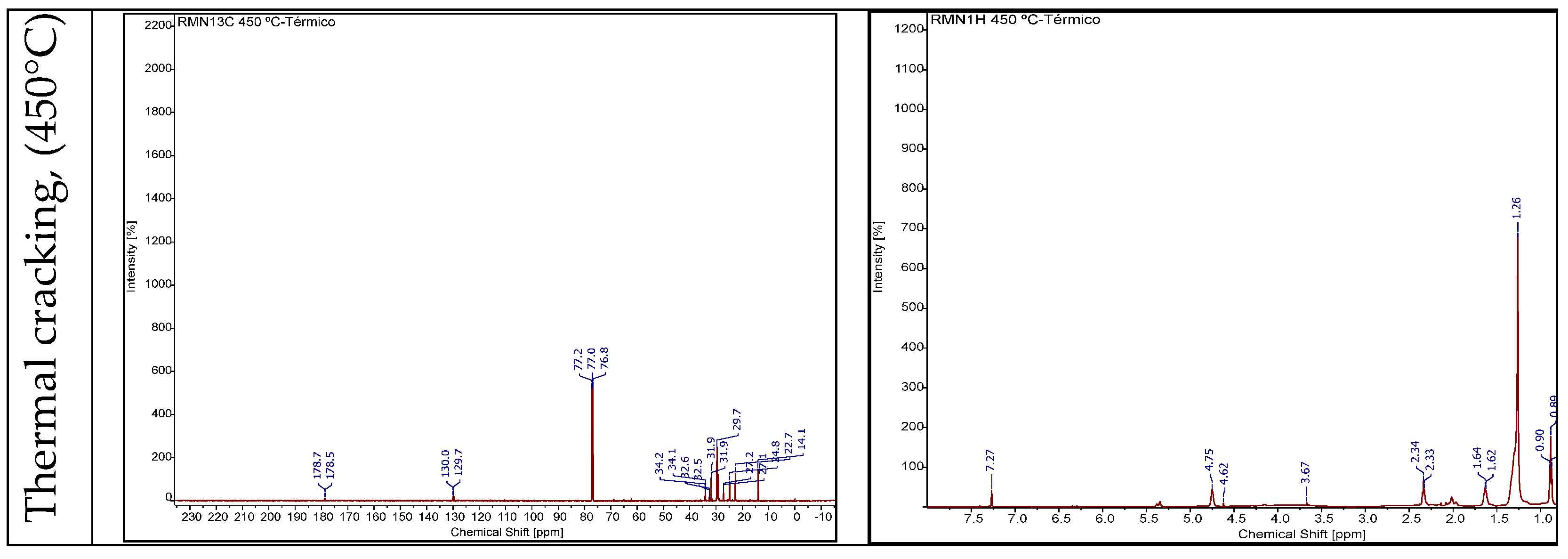
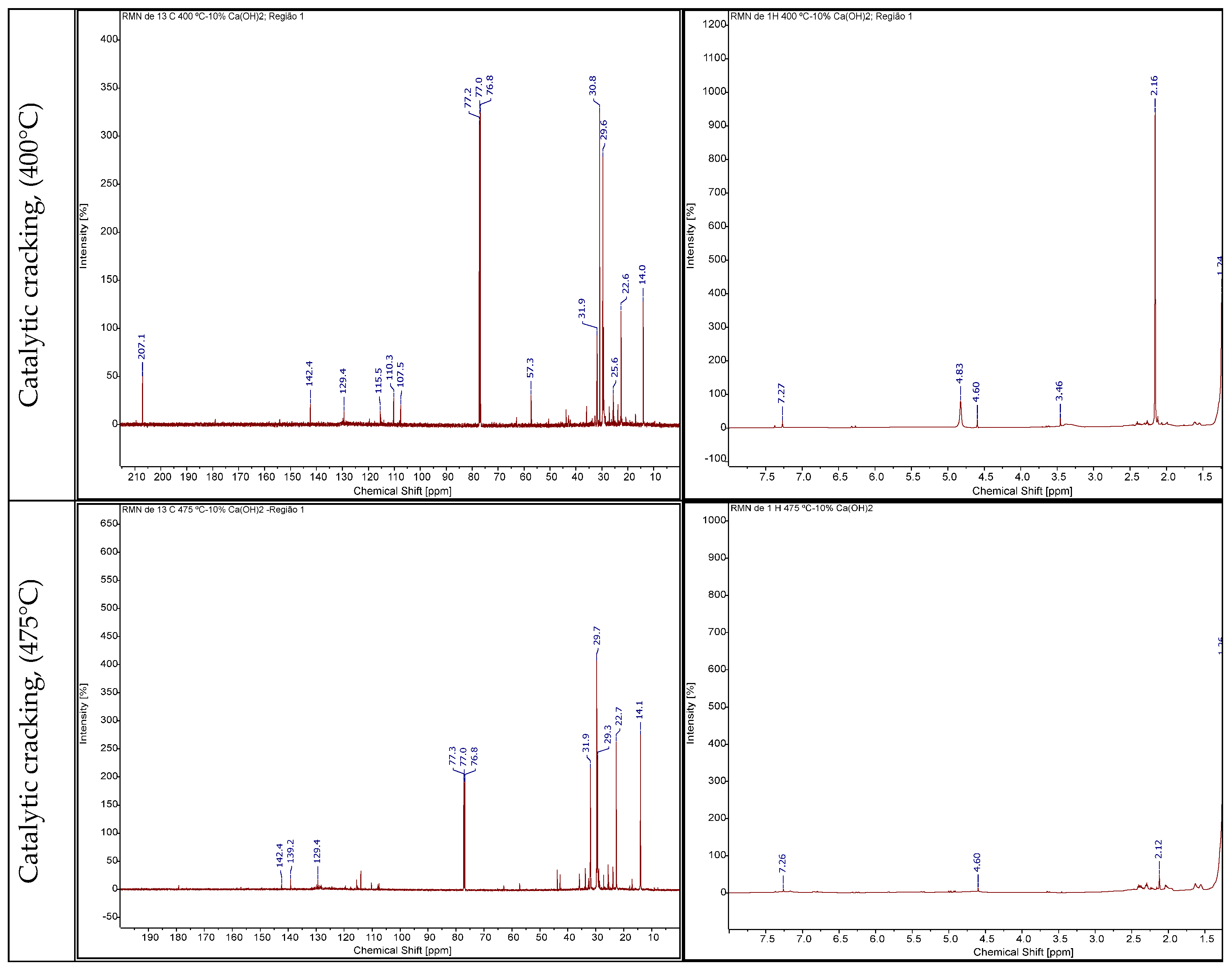
In the 13C NMR spectra of the bio-oil from the experiment referring to thermal pyrolysis at 450°C, the presence of chemical shifts relative to carbons in the range of 178.7 to 178.5 ppm was noted, which is generally attributed to carbonyl group carbons (C =O), as in carboxylic acids, esters, amides. The NMR spectra of the sample show sign characteristics of olefinic hydrocarbons with chemical shifts of carbons with double bonds observed at 115.5 and 139.2 ppm in the 13C NMR spectrum and linear aliphatic hydrocarbons with chemical shifts typical of long chain carbons CH2 (methylene) and CH3 (methyl group) between 14 to 31.9 ppm in the 13C NMR spectrum. The same can be observed in the 1H NMR spectrum with peaks (chemical shift) at 0.87 to 1.26 ppm, confirming the presence of aliphatic hydrocarbons, while peaks between 1.62 to 2.16 and close to 4.83 ppm, confirming the presence of hydrocarbons. olefins, corroborated by the infrared spectra presented. The chemical shift of 7.27 ppm is characteristic of protons linked to aromatic rings, as in benzene and its derivatives. This value indicates that the protons are unprotected due to the circulation of electrons in aromatic systems, which increases the chemical shift.
3.4.2.4. Gas Chromatography Analysis of Bio-Oil
Table 11 and Figure 16 illustrate the effect of temperature on the chemical composition, expressed in hydrocarbons, oxygenated and nitrogenous, of bio-oils obtained by thermal pyrolysis at 450°C and catalytic pyrolysis of the MSW fraction at 400 and 475°C , 1.0 atm, 10.0% (by mass) of Ca(OH)2, evaluating socioeconomic regions 1, 2 and 3, on a laboratory scale. The chemical functions (alcohols, carboxylic, oxygenated and nitrogenous acids), sum of peak areas, CAS numbers and retention times of all molecules identified in the bio-oil by GC-MS are illustrated in Supplementary Tables S1–S9 .
From GC-MS analysis of bio-oil obtained by pyrolysis of urban solid waste at 450 °C, the chemical compounds identified were aliphatic hydrocarbons (alkanes, al-kenes, cycloalkanes and cycloalkenes) and aromatic hydrocarbons (benzenes, indenes and naphthalenes). ) with total percentage concentration in area of 44.34, 49.34 and 40.07% for R1, R2 and R3, respectively. The oxygenated compounds (esters, ethers, phenols, carboxylic acids, ketones and aldehydes) presented a percentage in area of 42.09, 39.04 and 42.91% for R1, R2 and R3, respectively, in addition organic compounds containing nitrogen were identified at 9.22% , 7.22% and 12.40% and chlorine 4.34, % for R1, R2 and R3 in percentages of area. The results found are in line with the literature [39,67,88,89,90].
As a result, the difference found between regions R1, R2 and R3 was less than 4.0%, which can be explained due to the gravimetric composition of the solid waste collected and/or the socioeconomic classification of each region.
From GC-MS analysis of bio-oil obtained by pyrolysis of urban solid waste at 400 °C, using catalyst, aliphatic hydrocarbons (alkanes, alkenes, cycloalkanes and cycloalkenes) and aromatic hydrocarbons (benzenes, indenes and naphthalenes) with total concentration percentage in area of 71.32%, 68.16% and 69.70% for R1, R2 and R3, respectively. The oxygenated compounds (esters, carboxylic acids, alcohols, ketones and phenols) presented a percentage in area of 22.85%, 25.48% and 23.83% for R1, R2 and R3, respectively, in addition organic compounds containing nitrogen were identified in percentages in an area of 5.82%, 6.36% and 6.47% for R1, R2 and R3, respectively. The results found are in line with the literature [39,67,88,89,90]. As a result, a difference of less than 3% in the hydrocarbon composition between regions R1, R2 and R3, taking R1 as a reference, stands out, highlighting the difference found between regions R1 and R3, which was less than 1.0%. can be explained due to the addition of the Ca(OH)2 catalyst.
It is also worth highlighting the increase in the concentration [% area] of hydrocarbons in relation to experiments without catalyst at 450°C, and the decrease in oxygenated, nitrogenated and chlorinated compounds. In view of this, it appears that the Ca(OH)2 catalyst reduces the formation of these compounds in bio-oils produced regardless of the socio-economic classification of the region.
From the GC-MS analysis of bio-oil obtained by pyrolysis of urban solid waste at 475 °C, using a catalyst, the chemical compounds identified were aliphatic hydrocarbons (alkanes, alkenes, cycloalkanes and cycloalkenes) and aromatic hydrocarbons (benzenes, indenes and naphthalenes) with total percentage concentration in area of 65.69%, 67.53% and 66.77% for R1, R2 and R3, respectively. The oxygenated compounds (esters, carboxylic acids, alcohols, ketones and phenols) presented a percentage in area of 28.48%, 26.63% and 26.40% for R1, R2 and R3, respectively, in addition organic compounds were identified. having nitrogen in percentages in area of 5.82%, 5.83% and 6.82% for R1, R2 and R3, respectively. The results found are in line with the literature [39,67,88,89,90]. As a result, a difference of less than 2.0% in the composition of hydrocarbons between the regions R1, R2 and R3, taking R2 as a reference, was observed. In addition, a decrease in the production of oxygenates and nitrogenates was observed in relation to compared to experiments without a catalyst, that is, regardless of the temperature used and the socioeconomic classification of each region, the application of the Ca(OH)2 catalyst favored the formation of hydrocarbons. According to the quantification and identification of the compounds present in the bio-oil samples, the presence of major compounds was found to be: Benzene, (1-methylethyl)—D- Limonene for the R1 and R2 regions, o-xylene for the regions R1, R2 and R3 in experiments at 450°C; Dodecanoic acid, 9-Octadecenoic acid, ethyl ester and o-xylene for region R1, Phenol, Phenol, 4-ethyl-2-methoxy-e Phenol for region R2 and 2-Heptadecanone for region R3 in experiments at 400 °C with Ca(OH)2 catalyst; 2-Methyl-Z,Z-3,13-octadecadienol and 10-Octadecenoic acid, methyl ester, bis(2-ethylhexyl) o-Cymene ester for the R1 region, 9-Octadecene, 1-methoxy-, (E)- and Hexadecanoic acid, methyl ester, 10-Octadecenoic acid, methyl ester for the R2 region, Pentadecane and 2-Heptadecanone for the R3 region. The majority compounds can be applied, by the chemical and petrochemical industries, for the production of inputs, pharmaceuticals and polymers, in addition to combustible liquids, due to the percentage concentration in area below 30%, in all experiments carried out [39,67 ;88,89,90].
In view of this, it appears that the application of Ca(OH)2 catalyst favors the formation of hydrocarbons by reducing the concentration in area of oxygenated, nitrogenated and chlorinated in bio-oils, regardless of the temperature used in the process and the classification. socioeconomic cation of each region.
5. Conclusions
The thermal and catalytic pyrolysis resulted in a biochar with porous morphology and enriched with calcium compounds, as evidenced by SEM analysis. Although carbonization is partial, the porous properties and the presence of calcium particles make biochar promising for applications in environmental remediation, such as the adsorption of heavy metals and the neutralization of acids. However, the structural fragility and heterogeneous distribution of the catalyst can limit its efficiency under certain conditions. To optimize the use of this biochar, it would be important to consider adjustments to the pyrolysis process or a higher temperature to increase complete carbonization and improve the uniformity of the material.
In relation to XRD, catalytic pyrolysis with Ca(OH)₂ resulted in the formation of crystalline inorganic compounds, such as quartz, sylvite and calcite. The carbon in the organic fraction of MSW is predominantly in amorphous form, which is characteristic of biochars produced at moderate temperatures. The presence of quartz confirms the contamination of the MSW by mineral materials (sand), while sil-vita and calcite indicate the interaction of Ca(OH)₂ with the components present in the waste during the process. This suggests that the pyrolysis process was efficient in transforming organic matter and paper into biochar, while the minerals present can influence the properties of the final product.
The socioeconomic profile of the regions has a direct influence on the composition of urban solid waste, impacting the yields of pyrolysis by-products. In regions with lower income, the greater fraction of organic waste favors the production of bio-oil. In regions with higher income, where waste is less organic, there is an increase in biochar production. Temperature is another crucial factor in the distribution of pyrolysis products. The balance between biochar and bio-oil production occurs at around 450 °C. Lower temperatures tend to favor the formation of biochar, while higher temperatures promote greater yields of bio-oil and synthesis gas.
The addition of Ca(OH)₂ as a catalyst was more effective at higher temperatures (475 °C), where it contributed to increasing the bio-oil yield by intensifying the secondary pyrolysis of volatile compounds. The choice of temperature and catalyst is, therefore, crucial to optimize bio-oil production in the pyrolysis process.
The addition of Ca(OH)₂ in catalytic pyrolysis not only reduces the acidity index of the bio-oil and the aqueous phase, but also promotes deoxygenation, improving the quality of the bio-oil. These effects make the catalytic process essential for obtaining bio-oils with properties more favorable for use as fuel, reducing corrosion problems and increasing product stability.
The FT-IR spectrum confirms the presence of saturated and unsaturated hydrocarbons, in addition to carboxylic groups, which indicate the formation of compounds typical of the thermal decomposition of organic waste and paper.
The presence of aromatic groups and carboxylic acid salts also suggests that the bio-oil contains a complex mixture of organic compounds, many of which can be useful as fuels, but whose acidity may need additional treatment to avoid corrosion problems in practical applications.
The use of catalysts, such as Ca(OH)₂, appears to influence the formation of carboxylates and neutralize part of the acids formed, improving the final quality of the bio-oil. The NMR identified the presence of saturated and unsaturated hydrocarbons suggesting that the bio-oil has the potential to be used as a fuel source, with aliphatic and olefinic components suitable for this purpose.
The GC-MS analysis of bio-oils obtained by pyrolysis of urban solid waste (MSW) reveals that the application of the Ca(OH)₂ catalyst favored the formation of hydrocarbons, regardless of the temperature (400°C, 450°C , 475°C) and the socioeconomic classification of the regions studied. An increase in the concentration of hydrocarbons and a significant reduction in oxygenated, nitrogenous and chlorinated compounds was observed, which are less desirable due to their lower energy efficiency and corrosion problems.
Furthermore, the variation between the chemical compositions of different regions was less than 4%, suggesting that the socioeconomic classification has little impact on the quality of the bio-oil when using the catalyst. The major compounds identified, such as benzene, d-limonene, fatty acids and esters, can be applied in the chemical, petrochemical and fuel industries, reinforcing the economic value of bio-oils. In conclusion, the addition of Ca(OH)₂ is beneficial to the pyrolysis process, improving the production of hydrocarbons and minimizing unwanted compounds, regardless of the socioeconomic origin of the MSW.
Supplementary Materials
The following supporting information can be downloaded at the website of this paper posted on Preprints.org, Table S1: Classes of compounds, summation of peak areas, CAS number, and retention times of chemical compounds identified by GC-MS in bio-oil by pyrolysis of (organic matter and paper) fraction from MSW at 450 °C, 1.0 atm, in laboratory scale for Socioeconomic Region 1. Table S2: Classes of compounds, summation of peak areas, CAS number, and retention times of chemical compounds identified by CG-MS in bio-oil by pyrolysis of (organic matter and paper) fraction from MSW at 450 °C, 1.0 atm, in laboratory scale for socioeconomic Region 2. Table S3: Classes of compounds, summation of peak areas, CAS number, and retention times of chemical compounds identified by CG-MS in bio-oil by pyrolysis of (organic matter and paper) fraction from MSW at 450 °C, 1.0 atm, in laboratory scale for Socioeconomic Region 3. Table S4: Classes of compounds, summation of peak areas, CAS number, and retention times of chemical compounds identified by CG-MS in bio-oil by thermal catalytic cracking of (organic matter and paper) fraction from MSW at 400 °C, 1.0 atm, 10.0% (wt.) of Ca(OH)2, in laboratory scale for Socioeconomic Region 1. Table S5: Classes of compounds, summation of peak areas, CAS number, and retention times of chemical compounds identified by CG-MS in bio-oil by thermal catalytic cracking of (organic matter and paper) fraction from MSW at 400 °C, 1.0 atm, 10.0% (wt.) of Ca(OH)2, in laboratory scale for Socioeconomic Region 2. Table S6: Classes of compounds, summation of peak areas, CAS number, and retention times of chemical compounds identified by CG-MS in bio-oil by thermal catalytic cracking of (organic matter and paper) fraction from MSW at 400 °C, 1.0 atm, 10.0% (wt.) of Ca(OH)2, in laboratory scale for Socioeconomic Region 3. Table S7: Classes of compounds, summation of peak areas, CAS number, and retention times of chemical compounds identified by CG-MS in bio-oil by thermal catalytic cracking of (organic matter and paper) fraction from MSW at 475 °C, 1.0 atm, 10.0% (wt.) of Ca(OH)2, in laboratory scale for Socioeconomic Region 1. Table S8: Classes of compounds, summation of peak areas, CAS number, and retention times of chemical compounds identified by CG-MS in bio-oil by thermal catalytic cracking of (organic matter and paper) fraction from MSW at 475 °C, 1.0 atm, 10.0% (wt.) of Ca(OH)2, in laboratory scale for Socioeconomic Region 2. Table S9: Classes of compounds, summation of peak areas, CAS number, and retention times of chemical compounds identified by CG-MS in bio-oil by thermal catalytic cracking of (organic matter and paper) fraction from MSW at 475 °C, 1.0 atm, 10.0% (wt.) of Ca(OH)2, in laboratory scale for Socioeconomic Region 3.
Author Contributions
The individual contributions of all the co-authors are provided as follows: F.P.d.C.A. contributed with formal analysis and writing original draft preparation, investigation and methodology, J.C.C.d.S. contributed with formal analysis, investigation and methodology, F.F.S.A. contributed with formal analysis, investigation and methodology, S.P.A.d.S. contributed with formal analysis, investigation and methodology, M.C.S. contributed with investigation and methodology, D.A.R.d.C. contributed with investigation and methodology, J.F.H.F. contributed with investigation and methodology, N.M.M. contributed with investigation and methodology, M.S.C.d.N. contributed with investigation and methodology, J.A.R.P. contributed with resources, chemical analysis, A.C.P.A. contributed with SIG analysis,L.E.P.B. with co-supervision, and resources, J.A.R.P. contributed with supervision, conceptualization, and data curation, and N.T.M. contributed with supervision, conceptualization, and data curation. All authors have read and agreed to the published version of the manuscript.
Funding
This research received no external funding.
Institutional Review Board Statement
Not applicable.
Informed Consent Statement
Not applicable.
Acknowledgments
I would like to acknowledge and dedicate this research in memory to Hélio da Silva Almeida, he used to work at the Faculty of Sanitary and Environmental Engineering/UFPa, and passed away on 13 March 2021. His contagious joy, dedication, intelligence, honesty, seriousness, and kindness will always be remembered in our hearts.
Conflicts of Interest
The authors declare no conflict of interest.
References
- Hoornweg, D.; Bhada-Tata, P. What a Waste: A Global Review of Solid Waste Management; World Bank: New York, NY, USA, 2012.
- Kaza, S.; Yao, L.; Bhada-Tata, P.; Van Woerden, F. What a Waste 2.0: A Global Snapshot of Solid Waste Management to 2050; The World Bank: Washington, DC, USA, 2018.
- JAMBECK, J. R. et al. Plastic waste inputs from land into the ocean. Science, v. 347, p. 768-771, 2015. [CrossRef]
- BRAZILIAN ASSOCIATION OF PUBLIC CLEANING AND SPECIAL WASTE COMPANIES—ABRELPE. Panora-ma 2020. São Paulo: ABRELPE, 2021;
- SILVA, Diego Rodrigues Borges da; COSTA FILHO, Itair da Silva; SOUZA, Waryson Carlos Silva de; SANTOS, Filip-pe Vilhena dos; MACHADO, Paulo Christian de Freitas; BRANDÃO, Isaque Wilkson de Sousa; PEREIRA, Filipe Castro; ASSUNAÇÃO, Maurilo André da Cunha; SILVA, Rafael Haruo Yoshida; RUSSO, Mario Augusto Tavares; MENDON-ÇA, Neyson Martins. Quantitative and Qualitative Aspects of Urban Solid Waste in the Municipalities of Ananin-deua, Belém and Marituba. In: PEREIRA, Christiane; FRICKE, Klaus (coordination). Intersectoral Cooperation and Innovation: tools for sustainable solid waste management. Braunschweig: Technische Universität Braunschweig, 2022.
- UNITED NATIONS DEVELOPMENT PROGRAM (UNDP). Accompanying the 2030 agenda for sustainable development: initial input from the United Nations System in Brazil on the identification of national indicators relating to sustainable development objectives/United Nations Development Program. Brasília: PNUD, 2015. Available at <http://www.br.undp.org/content/brazil/pt/home/library/ods/acomprando-a-agenda2030.html> Accessed on March 10, 2018.
- S. Alam, K.S. Rahman, M. Rokonuzzaman, P.A. Salam, M.S. Miah, N. Das, S. Chowdhury, S. Channumsin, S. Sreesawet, M. Channumsin. Selection of Waste to Energy Technologies for Municipal Solid Waste Management—Towards Achieving Sustainable Development Goals. Sustainability, 14 (19) (2022), p. 11913; doi. [CrossRef]
- MENEZES, Rosana Oliveira; CASTRO, Samuel Rodrigues; SILVA, Jonathas Batista Gonçalves; TEIXEIRA, Gisele Pereira; SILVA, Marco Aurélio Miguel. Statistical analysis of the gravimetric characterization of household solid waste: case study from the city of Juiz de Fora, Minas Gerais. Sanitary and Environmental Engineering, v. 24, no. 2, p. 271-282. DOI. [CrossRef]
- BRENNAN, R. B. et al. Management of landfill leachate: the legacy of European Union Directives. Waste Management, 2015. [CrossRef]
- SAMADDER, S. R. et al. Analysis of the contaminants released from municipal solid waste landfill site: A case study. Science Total Environmental, [S.l.], 2016. [CrossRef]
- UNEP—Finance Initiative. Financing Circularity: Demystifying Finance for Circular Economies. 2020. Disponível em: https://www.unep.org/resources/report/financing-circularity-demystifying finance-circular-economy. Acesso em: 12 out. 2022.
- Silva, Rodrigo Cândido Passos da; COSTA, Amanda Rodrigues Santos; Eldeir, Soraya Giovanetti; Jucá, José Fernando Thomé. Sectorization of household solid waste collection routes using multivariate techniques: case study from the city of Recife, Brazil. Sanitary and Environmental Engineering, v. 25, no. 6, p. 821-832, 2020. [CrossRef]
- LENZ, S.; BÖHM, K.; OTTNER, R.; HUBER-HUMER, M. (2016) Determination of leachate compounds relevant for landfill aftercare using FT-IR spectroscopy. Waste Management, v. 55, p. 321-329. [CrossRef]
- Alsayed Alsobky, Mostafa Ahmed, Sherien Al Agroudy, Khaled El Araby. A smart framework for municipal solid waste collection management: A case study in Greater Cairo Region. Ain Shams Engineering Journal. Volume 14, Issue 6. 2023. 102183. ISSN 2090-4479. [CrossRef]
- BANAR, M.; ÖZCAN, A. (2008). Characterization of the Municipal Solid Waste in Eskisehir City, Turkey. Enviromental Engineering Science, v. 25, n. 8, p. 1213-1219. [CrossRef]
- MIEZAH, K.; OBIRI-DANSO, K.; KÁDÁR, Z.; FEI-BAFFOE, B.; MENSAH, M. (2015) Municipal solid waste characterization and quantification as a measure towards effective waste management in Ghana, Waste Management, v. 46, p. 15-27. [CrossRef]
- OGWUELEKA, T.C. (2013) Survey of household waste composition and quantities in Abuja, Nigeria. Resources, Conservation and Recycling, v. 77, p. 52-60. [CrossRef]
- COSTA, L.E.B.; COSTA, S.K.; REGO, N.A.C.; SILVA JÚNIOR, M.F. (2012) Gravimetry of household urban solid waste and socioeconomic profile in the municipality of Salinas, Minas Gerais. Ibero-American Journal of Environmental Sciences, v. 3, n. 2, p. 73-90. [CrossRef]
- OZCAN, H.K.; GUVENC, S.Y.; GUVENC, L.; DEMIR, G. (2016) Municipal Solid Waste Characterization according to Different Income Levels: A Case Study. Sustainability, v. 8, n. 10, p. 1044. [CrossRef]
- Carneiro, Paulo Fernando Norat. Characterization and evaluation of the economic potential of selective collection and recycling of household solid waste generated in the municipalities of Belém and Ananindeua—PA. 2006. Dissertation (Master’s in Civil Engineering)—Postgraduate Program in Civil Engineering (PPGEC), Institute of Technology (ITEC), Technological Center, Federal University of Pará, Belém, 2006. Available at: http://www.repositorio.ufpa.br:8080/jspui/handle/2011/1899;
- Frishammar, J., & Parida, V. (2019). Circular Business Model Transformation: A Roadmap for Incumbent Firms. California Management Review, 61(2), 5-29. [CrossRef]
- da Mota, S.; Mancio, A.; Lhamas, D.; de Abreu, D.; da Silva, M.; dos Santos, W.; de Castro, D.; de Oliveira, R.; Araújo, M.; Borges, L.E.; et al. Production of green diesel by thermal catalytic cracking of crude palm oil (Elaeis guineensis Jacq) in a pilot plant. J. Anal. Appl. Pyrolysis 2014, 110, 1–11. [CrossRef]
- LHAMAS, D. E. L. et al. Study of the Thermocatalytic Cracking Process of Palm Oil (Elaeis guineensis) Neutralized on Semi-Pilot Scale and Laboratory Scale. In: 4th National Biofuels Symposium, 2011, Rio de Janeiro.
- SANTOS, M.C. Study of the thermolytic cracking process of palm oil neutralization sludge for biofuel production. 2015. 241 f. Thesis (Doctorate in Amazon Natural Resources Engineering)—Federal University of Pará, Belém, 2011.
- Almeida, H.D.S.; Corrêa, O.; Ferreira, C.; Ribeiro, H.; de Castro, D.; Pereira, M.; Mâncio, A.D.A.; Santos, M.; da Mota, S.; Souza, J.D.S.; et al. Diesel-like hydrocarbon fuels by catalytic cracking of fat, oils, and grease (FOG) from grease traps. J. Energy Inst. 2016, 90, 337–354. DOI. [CrossRef]
- PEREIRA, L. M. Study of the sewage sludge cracking process, at different scales, aiming at alternative uses—Doctoral Thesis, Federal University of Pará. Institute of technology, Postgraduate Program in Natural Resources Engineering of the Amazon. Belém, 2019.
- BRIDGWATER, A.V. Review of fast pyrolysis of biomass and product upgrading, Biomass Bioenergy, 38, 68—94, 2012. [CrossRef]
- Czajczynska D, Anguilano L, Ghazal H, Krzy˙ zy’nska R, Reynolds AJ, Spencer N, et al. Potential of pyrolysis processes in the waste management sector. Thermal Science and Engineering Progress 2017,3:171–97.
- Grycová B, Koutník I, Pryszcz A. Pyrolysis process for the treatment of food waste. Bioresour Technol 2016,218:1203–7. [CrossRef]
- Yang Y, Heaven S, Venetsaneas N, Banks CJ, Bridgwater AV. Slow pyrolysis of organic fraction of municipal solid waste (OFMSW): characterisation of products and screening of the aqueous liquid product for anaerobic digestion. Appl Energy 2018,213:158–68. [CrossRef]
- Opatokun SA, Strezov V, Kan T. Product based evaluation of pyrolysis of food waste and its digestate. Energy 2015,92:349–54. [CrossRef]
- Ben Hassen-Trabelsi A, Kraiem T, Naoui S, Belayouni H. Pyrolysis of waste animal fats in a fixed-bed reactor: production and characterization of bio-oil and bio- char. Waste Manag 2014,34:210–8. [CrossRef]
- González JF, Rom´ an S, Encinar JM, Martínez G. Pyrolysis of various biomass residues and char utilization to produce activated carbons. J Anal Appl Pyrol 2009,85:134–41;
- Liu H, Ma X, Li L, Hu Z, Guo P, Jiang Y. The catalytic pyrolysis of food waste by microwave heating. Bioresour Technol 2014,166:45–50. [CrossRef]
- Serio M, Kroo E, Florczak E, W´ojtowicz M, Wignarajah K, Hogan J, et al. Pyrolysis of mixed solid food, paper, and packaging wastes. SAE International 2008.
- Xu F, Ming X, Jia R, Zhao M, Wang B, Qiao Y, et al. Effects of operating parameters on products yield and volatiles composition during fast pyrolysis of food waste in the presence of hydrogen. Fuel Process Technol 2020,210:106558. [CrossRef]
- Strezov V, Evans TJ. Thermal processing of paper sludge and characterisation of its pyrolysis products. Waste Manag 2009,29:1644–8. [CrossRef]
- Nurul Islam M, Nurul Islam M. Rafiqul Alam Beg M, Rofiqul Islam M. Pyrolytic oil from fixed bed pyrolysis of municipal solid waste and its characterization. Renew Energy 2005,30:413–20.
- Chen C, Jin Y, Chi Y. Effects of moisture content and CaO on municipal solid waste pyrolysis in a fixed bed reactor. J Anal Appl Pyrol 2014,110:108–12. [CrossRef]
- Biswal B, Kumar S, Singh RK. Production of hydrocarbon liquid by thermal pyrolysis of paper cup waste. Journal of Waste Management 2013,2013:7. [CrossRef]
- Li L, Zhang H, Zhuang X. Pyrolysis of waste paper: characterization and composition of pyrolysis oil. Energy Sources 2005,27:867–73. [CrossRef]
- Wu C-H, Chang C-Y, Tseng C-H. Pyrolysis products of uncoated printing and writing paper of MSW. Fuel 2002,81:719–25. [CrossRef]
- Jk M, Namjoshi S, Channiwala S. Kinetics and pyrolysis of glossy paper waste. Int J Eng Res Gen Sci 2012,2:1067–74.
- Sarkar A, Chowdhury R. Co-pyrolysis of paper waste and mustard press cake in a semi-batch pyrolyzer—optimization and bio-oil characterization. Int J Green Energy 2016,13:373–82. [CrossRef]
- Bhuiyan M, Murakami K, Ota M. On thermal stability and chemical kinetics of waste newspaper by thermogravimetric and pyrolysis analysis. J Environ Eng 2008,3:1–12. [CrossRef]
- Wu C-H, Chang C-Y, Tseng C-H, Lin J-P. Pyrolysis product distribution of waste newspaper in MSW. J Anal Appl Pyrol 2003,67:41–53; [CrossRef]
- Veses A, Sanahuja-Parejo O, Call´ en MS, Murillo R, García T. A combined two- stage process of pyrolysis and catalytic cracking of municipal solid waste for the production of syngas and solid refuse-derived fuels. Waste Manag 2020,101:171–9.
- Ding K, Zhong Z, Zhong D, Zhang B, Qian X. Pyrolysis of municipal solid waste in a fluidized bed for producing valuable pyrolytic oils. Clean Technol Environ Policy 2016,18:1111–21. [CrossRef]
- Luo S, Xiao B, Hu Z, Liu S, Guan Y, Cai L. Influence of particle size on pyrolysis and gasification performance of municipal solid waste in a fixed bed reactor. Bioresour Technol 2010,101:6517–20. [CrossRef]
- Mamad Gandidi I, Susila MD, Agung Pambudi N. Production of valuable pyrolytic oils from mixed Municipal Solid Waste (MSW) in Indonesia using non-isothermal and isothermal experimental. Case Studies in Thermal Engineering 2017,10:357–61.
- Zhang A, Xiao L, Wu D. Anaerobic pyrolysis characteristics of municipal solid waste under high temperature heat source. Energy Procedia 2015,66:197–200. [CrossRef]
- Wang N, Qian K, Chen D, Zhao H, Yin L. Upgrading gas and oil products of the municipal solid waste pyrolysis process by exploiting in-situ interactions between the volatile compounds and the char. Waste Manag 2020,102:380–90. [CrossRef]
- Tursunov O. A comparison of catalysts zeolite and calcined dolomite for gas production from pyrolysis of municipal solid waste (MSW). Ecol Eng 2014,69: 237–43. [CrossRef]
- Baggio P, Baratieri M, Gasparella A, Longo GA. Energy and environmental analysis of an innovative system based on municipal solid waste (MSW) pyrolysis and combined cycle. Appl Therm Eng 2008,28:136–44. [CrossRef]
- Fang S, Yu Z, Lin Y, Hu S, Liao Y, Ma X. Thermogravimetric analysis of the co- pyrolysis of paper sludge and municipal solid waste. Energy Convers Manag 2015,101:626–31. [CrossRef]
- Paula, T.P.; Marques, M.F.V.; Marques, M.R.D.C. Influence of mesoporous structure ZSM-5 zeolite on the degradation of Urban plastics waste. J. Therm. Anal. 2019, 138, 3689–3699.
- Vakalis, S.; Sotiropoulos, A.; Moustakas, K.; Malamis, D.; Vekkos, K.; Baratieri, M. Thermochemical valorization and characterization of household biowaste. J. Environ. Manag. 2017, 203, 648–654; [CrossRef]
- Chen,C.; Jin, Y.; Chi, Y. Effects of moisture content and CaO on municipal solid waste pyrolysis in a fixed bed reactor.J. Anal. Appl. Pyrolysis 2014, 110, 108–112; [CrossRef]
- Veses, A.; Sanahuja-Parejo, O.; Callén, M.S.; Murillo, R.; García, T. A combined two-stage process of pyrolysis and catalytic cracking of municipal solid waste for the production of syngas and solid refuse-derived fuels. Waste Manag. 2019, 101, 171–179. [CrossRef]
- Lohri, C.R.; Faraji, A.; Ephata, E.; Rajabu, H.M.; Zurbrügg, C. Urban biowaste for solid fuel production: Waste suitability assessment and experimental carbonization in Dar es Salaam, Tanzania. Waste Manag. Res. J. A Sustain. Circ. Econ. 2015, 33, 175–182; [CrossRef]
- Phan, A.N.; Ryu, C.; Sharifi, V.N.; Swithenbank, J. Characterisation of slow pyrolysis products from segregated wastes for energy production. J. Anal. Appl. Pyrolysis 2008, 81, 65–71; [CrossRef]
- Shi, H.; Mahinpey, N.; Aqsha, A.; Silbermann, R. Characterization, thermochemical conversion studies, and heating value modeling of municipal solid waste. Waste Manag. 2016, 48, 34–47; [CrossRef]
- Miskolczi, N.; Ate¸ s, F.; Borsodi, N. Comparison of real waste (MSW and MPW) pyrolysis in batch reactor over different catalysts. Part II: Contaminants, char and pyrolysis oil properties. Bioresour. Technol. 2013, 144, 370–379.
- AlDayyat, E.; Saidan, M.; Al-Hamamre, Z.; Al-Addous, M.; Alkasrawi, M. Pyrolysis of Solid Waste for Bio-Oil and Char Production in Refugees’ Camp: A Case Study. Energies 2021, 14, 3861. [CrossRef]
- Sørum,L.; Grønli, M.G.; Hustad, J.E. Pyrolysis characteristics and kinetics of municipal solid wastes. Fuel 2001, 80, 1217–1227. [CrossRef]
- Song, Q.; Zhao, H.-Y.; Xing, W.-L.; Song, L.-H.; Yang, L.; Yang, D.; Shu, X. Effects of various additives on the pyrolysis characteristics of municipal solid waste. Waste Manag. 2018, 78, 621–629. [CrossRef]
- Ates, F.; Miskolczi, N.; Borsodi, N. Comparision of real waste (MSW and MPW) pyrolysis in batch reactor over different catalysts. Part I: Product yields, gas and pyrolysis oil properties. Bioresour. Technol. 2013, 133, 443–454. [CrossRef]
- Liu, G.; Liao, Y.; Guo, S.; Ma, X.; Zeng, C.; Wu, J. Thermal behavior and kinetics of municipal solid waste during pyrolysis and combustion process. Appl. Therm. Eng. 2016, 98, 400–408. [CrossRef]
- FOGLER, H.S. Elementos de Engenharia de reações Químicas. Editora LTC, 4 ed.2009.
- CHEW, T. L; BHATIA, S. Effect of catalyst additives on the production of biofuels from palm oil cracking in a transport riser reactor. Bioresource Technology, v. 100, p.2540–2545, 2009. [CrossRef]
- Konwer et al., 1989 D. Konwer, S.E. Taylor, B.E. Gordon, J.W. Otvos, M. Calvin. Liquid fuels from Messua ferra L. seed oil. J. Am. oil Chem. Soc., 66 (1989), pp. 223-226.
- Tursunov, O. A comparison of catalysts zeolite and calcined dolomite for gas production from pyrolysis of municipal solid waste (MSW). Ecol. Eng. 2014, 69, 237–243. [CrossRef]
- Assunção, F.P.d.C.; Pereira, D.O.; da Silva, J.C.C.; Ferreira, J.F.H.; Bezerra, K.C.A.; Bernar, L.P.; Ferreira, C.C.; Costa, A.F.d.F.; Pereira, L.M.; da Paz, S.P.A.; et al. A Systematic Approach to Thermochemical Treatment of Municipal Household Solid Waste into Valuable Products: Analysis of Routes, Gravimetric Analysis, Pre-Treatment of Solid Mixtures, Thermochemical Processes, and Characterization of Bio-Oils and Bio-Adsorbents. Energies 2022, 15, 7971. [CrossRef]
- Pereira, D.O.; da Costa Assunção, F.P.; da Silva, J.C.C.; Ferreira, J.F.H.; Ferreira, R.B.P.; Lola, Á.L.; do Nascimento, Í.C.P.; Chaves, J.P.; do Nascimento, M.S.C.; da Silva Gouvêa, T.; et al. Prediction of Leachate Characteristics via an Analysis of the Solubilized Extract of the Organic Fraction of Domestic Solid Waste from the Municipality of Belém, PA. Sustainability 2023, 15, 15456. [CrossRef]
- BELÉM. Lei Municipal nº 9.656, de 30 de dezembro de 2020. Institui a Política Municipal de Saneamento Básico do Município de Belém, o Plano Municipal de Saneamento Básico (PMSB), e o Plano de Gestão Integrada de Resíduos Sólidos (PGIRS), em Atenção ao Disposto no Art. 9º da Lei Federal nº 11.445/2007, com as Atualizações Trazidas pela Lei nº 14.026/2020, o Novo Marco do Saneamento Básico, e dá Outras Providências. Belém, PA, 30 dez. 2020. Available online: https://arbel.belem.pa.gov.br/wp-content/uploads/2022/05/PMGIRS-INTEGRAL.pdf (accessed on 1 August 2022).
- IBGE. Instituto Brasileiro de Geografia e Estatística. Censo Brasileiro de 2010; IBGE: Rio de Janeiro, Brazil, 2012. Available online: https://censo2010.ibge.gov.br/ (accessed on 1 August 2022).
- NBR10.007. Amostragem de Resíduos Sólidos. ABNT—Associação Brasileira de Normas Técnicas: Rio de Janeiro, Brazil, 2004.
- L. Botti, D. Battini, F. Sgarbossa, C. Mora Door-to-Door Waste Collection : Analysis and Recommendations for Improving Ergonomics in an Italian Case Study. Waste Manag., 109 (2020), pp. 149-160. [CrossRef]
- de Castro, D.R.; Ribeiro, H.D.S.; Guerreiro, L.H.; Bernar, L.P.; Bremer, S.J.; Santo, M.C.; Almeida, H.D.S.; Duvoisin, S.; Borges, L.P.; Machado, N.T. Production of Fuel-Like Fractions by Fractional Distillation of Bio-Oil from Açaí (Euterpe oleracea Mart.) Seeds Pyrolysis. Energies 2021, 14, 3713.
- Trazzi, P. A., Higa, A. R., Dieckow, J., Mangrich, A. S., & Higa, R. C. V. (2018). BIOCARVÃO:REALIDADE E POTENCIAL DE USO NO MEIO FLORESTAL. Ciência Florestal, 28(2), 875–887. [CrossRef]
- Cabrera-Penna, M.; Rodríguez-Páez, J. Calcium oxyhydroxide (CaO/Ca(OH)2) nanoparticles: Synthesis, characterization and evaluation of their capacity to degrade glyphosate-based herbicides (GBH). Adv. Powder Technol. 2020, 32, 237–25. [CrossRef]
- Hassani, E.; Feyzbar-Khalkhali-Nejad, F.; Rashti, A.; Oh, T.-S. Carbonation, Regeneration, and Cycle Stability of the Mechanically Activated Ca(OH)2 Sorbents for CO2 Capture: An In Situ X ray Diffraction Study. Ind. Eng. Chem. Res. 2020, 59, 11402–11411.
- Gopu, C.; Gao, L.; Volpe, M.; Fiori, L.; Goldfarb, J.L. Valorizing municipal solid waste: Waste to energy and activated carbons for water treatment via pyrolysis. J. Anal. Appl. Pyrolysis 2018, 133, 48–58.DOI. [CrossRef]
- Lefebvre, David; Williams, Adrian; Meersmans, Jeroen; Kirk, Guy J. D.; Sohi, Saran; Goglio, Pietro; Smith, Pete (2020): Modelling the potential for soil carbon sequestration using biochar from sugarcane residues in Brazil. In Sci Rep 10 (1), p. 19479. [CrossRef]
- TRANG, P.T.T.; DONG, H.Q.; TOAN, D.Q.; HANH, N.T.X.; THU, N.T. (2017) The Effects of Socio-economic Factors on Household Solid Waste Generation and Composition: A Case Study in Thu Dau Mot, Vietnam. Energy Procedia, v. 107, p. 253-258. [CrossRef]
- Da Silva, G.P.C.; Assunção, F.P.d.C.; Pereira, D.O.; Ferreira, J.F.H.; Mathews, J.C.; Sandim, D.P.R.; Borges, H.R.; do Nascimento, M.S.C.; Mendonça, N.M.; de Sousa Brandão, I.W.; et al. Analysis of the Gravimetric Composition of Urban Solid Waste from the Municipality of Belém/PA. Sustainability 2024, 16, 5438. [CrossRef]
- BUAH, W.K.; CUNLIFFE, A.M.; WILLIAMS, P.T. Characterization of products from the pyrolysis of municipal solid waste. Process safety and Environmental Protection, v. 85 (B5), p. 450-457, 2007; [CrossRef]
- Zhou, H.; Long, Y.; Meng, A.; Li, Q.; Zhang, Y. Classification of municipal solid waste components for thermal conversion in waste-to-energy research. Fuel 2015, 145, 151–157. [CrossRef]
- Mati, A.; Buffi, M.; Dell’Orco, S.; Lombardi, G.; Ramiro, P.M.R.; Kersten, S.R.A.; Chiaramonti, D. Fractional Condensation of Fast Pyrolysis Bio-Oil to Improve Biocrude Quality towards Alternative Fuels Production. Appl. Sci. 2022, 12, 4822; [CrossRef]
- Ghanavati, H.; Nahvi, I.; Karimi, K. Organic fraction of municipal solid waste as a suitable feedstock for the production of lipid by oleaginous yeast Cryptococcus aerius. Waste Manag. 2015, 38, 141–148. [CrossRef]
Figure 1.
Methodological scheme adopted in the research.
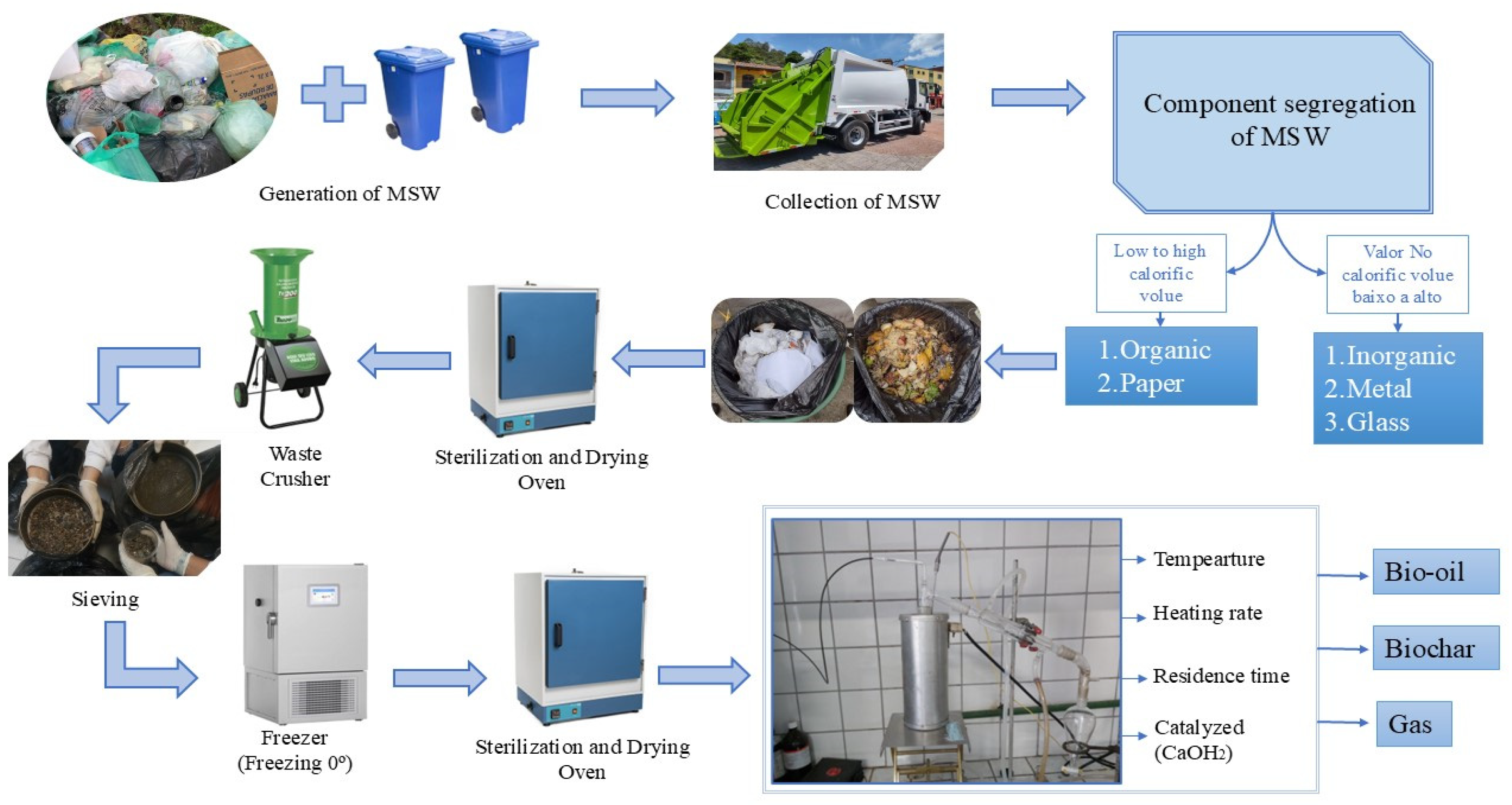
Figure 2.
Sectorization Map of Neighborhoods belonging to Lot 1.
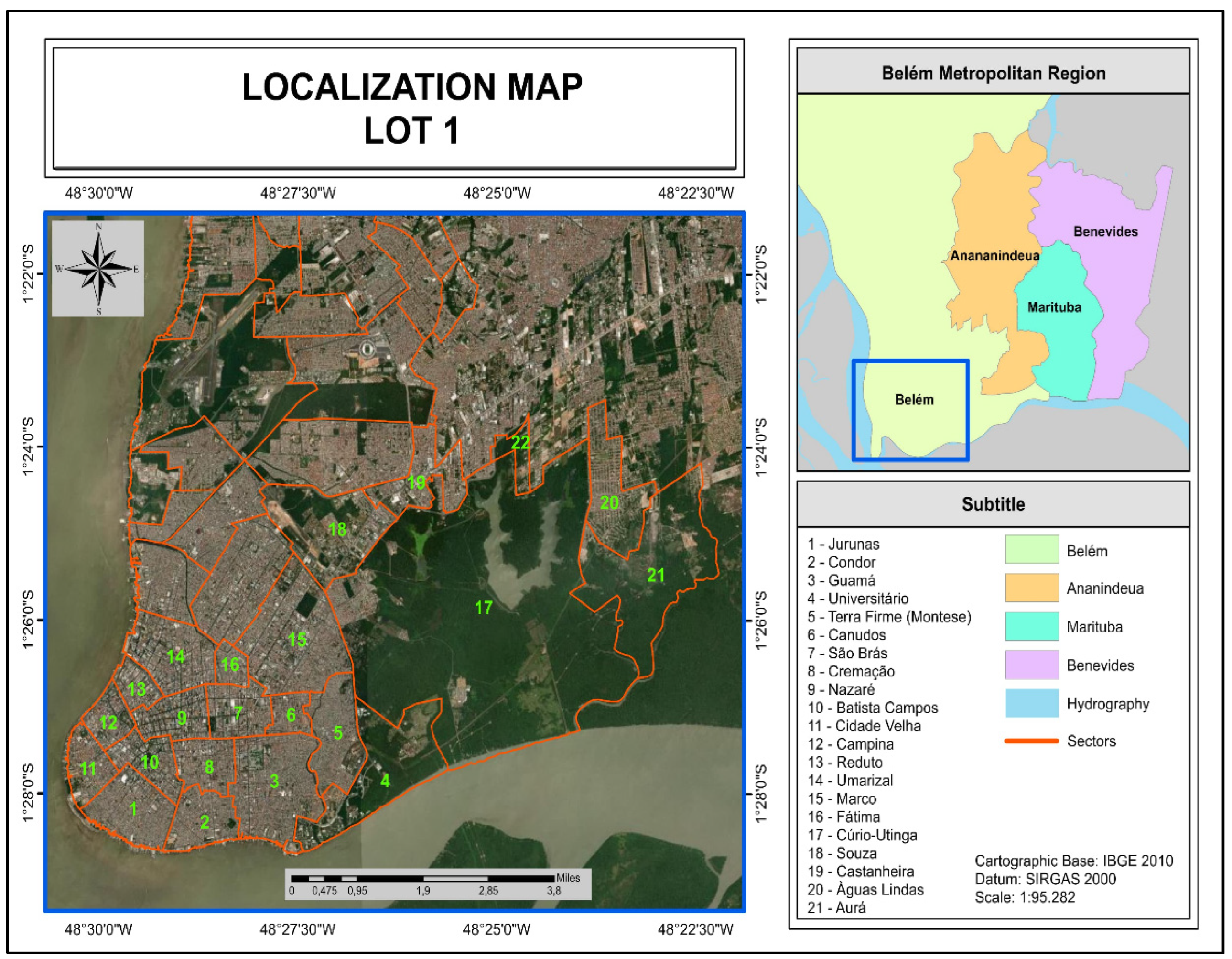
Figure 3.
Grouping of neighborhoods into sectors based on socioeconomic classification and geographic proximity.
Figure 3.
Grouping of neighborhoods into sectors based on socioeconomic classification and geographic proximity.
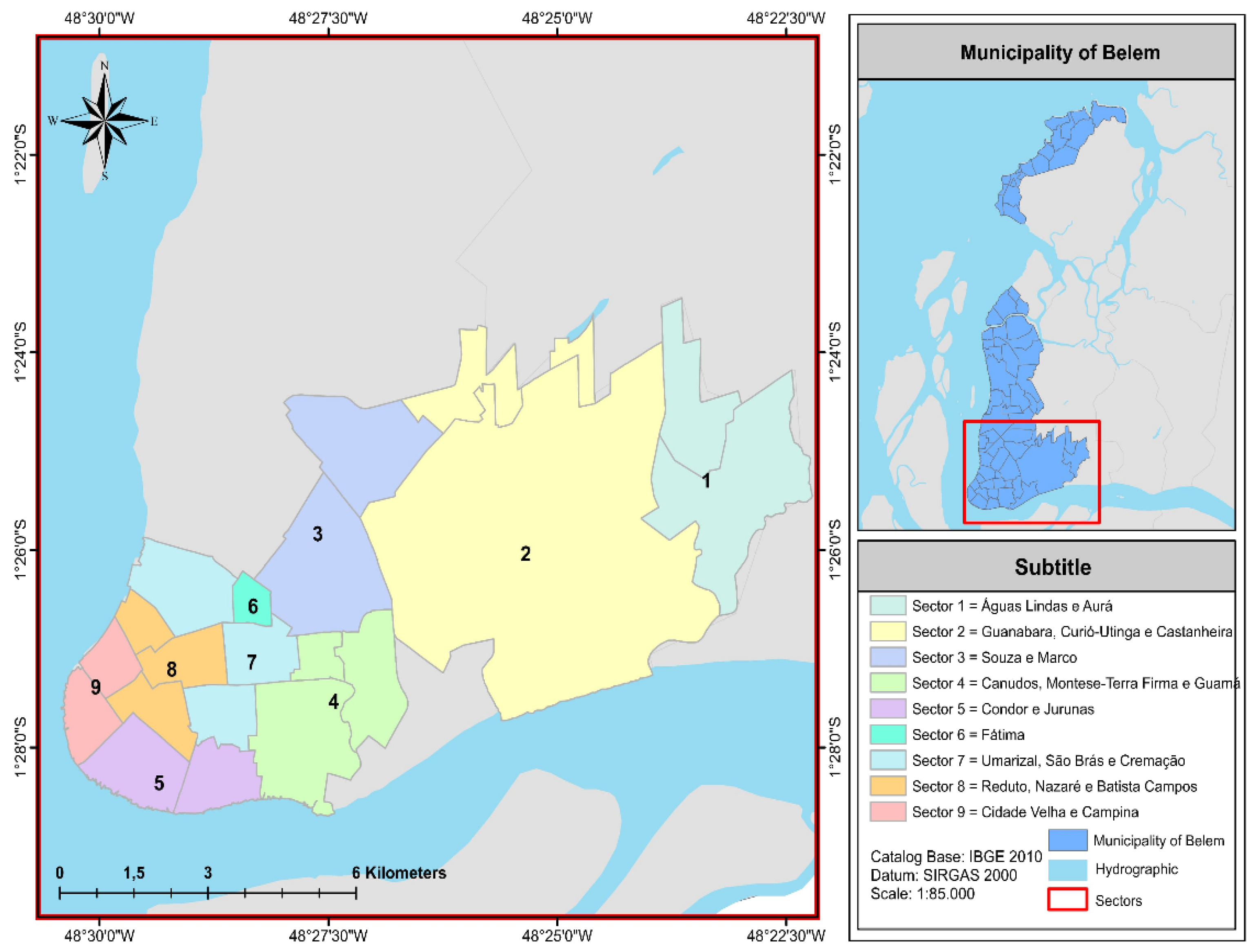
Figure 4.
Schema of laboratory scale borosilicate glass reactor.
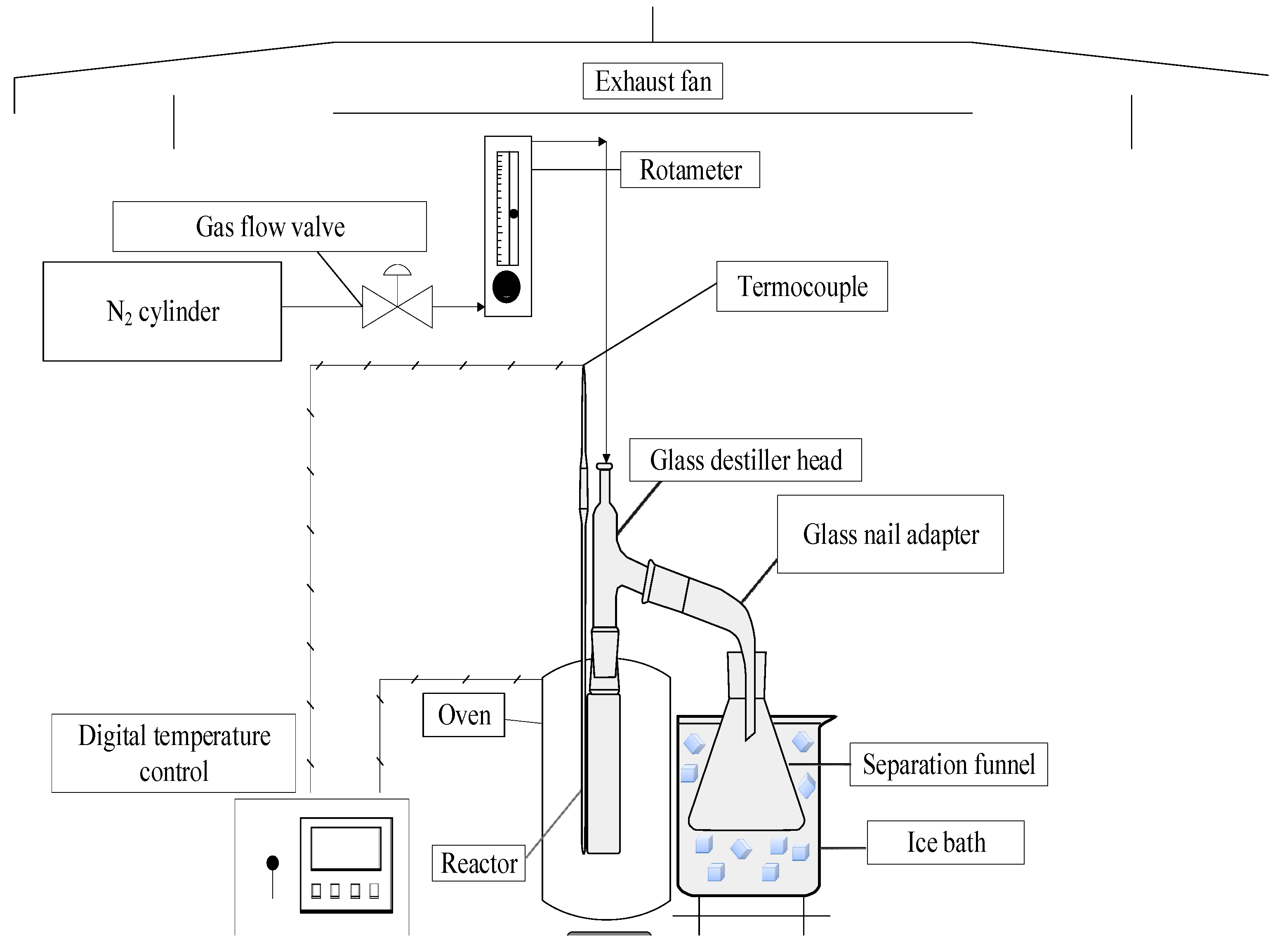
Figure 5.
SEM of biochar obtained by thermal pyrolysis of the fraction (organic matter and paper) of MSW at 450°C (a) Region 1 (b) Region 2 (c) Region 3, 1.0 atmosphere [MAG: 500 x and 1.0 kx ].
Figure 5.
SEM of biochar obtained by thermal pyrolysis of the fraction (organic matter and paper) of MSW at 450°C (a) Region 1 (b) Region 2 (c) Region 3, 1.0 atmosphere [MAG: 500 x and 1.0 kx ].
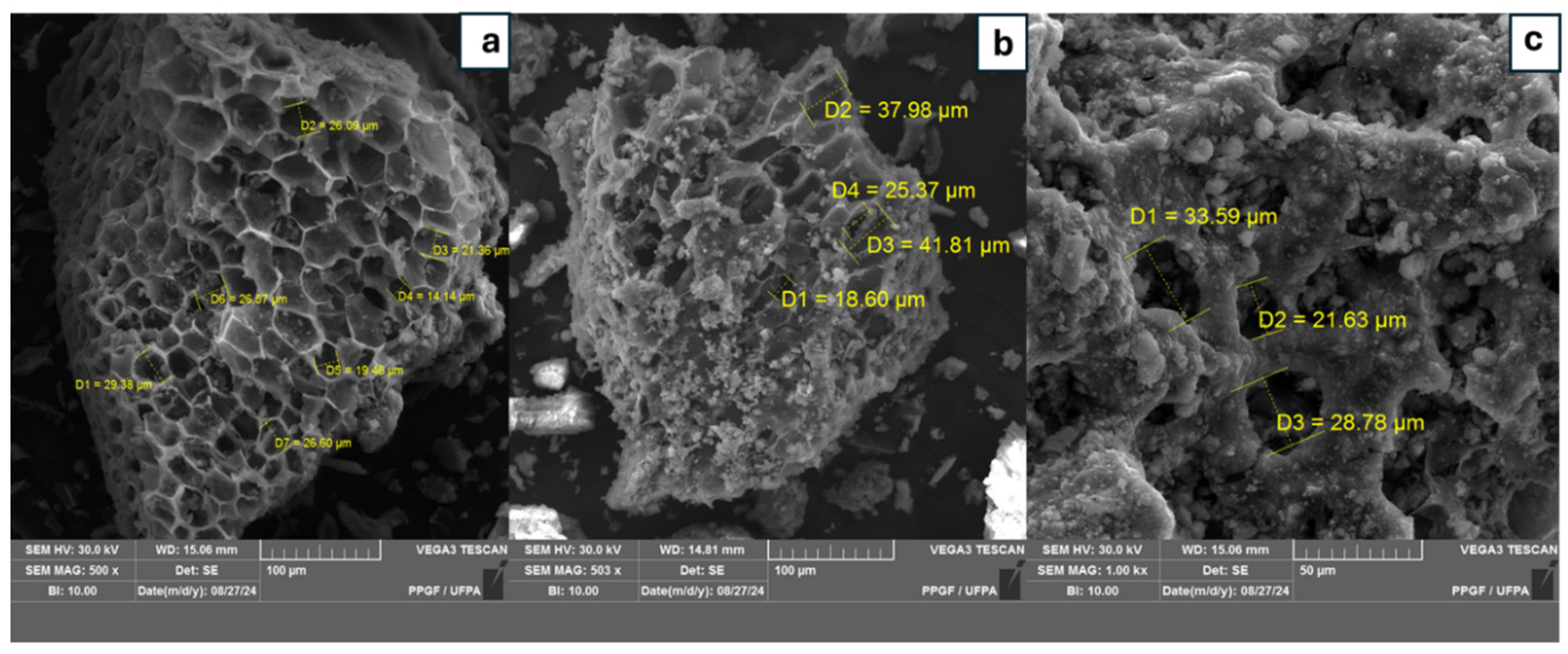
Figure 6.
SEM of biochar obtained by catalytic pyrolysis of the fraction (organic matter and paper) of MSW at 400°C 10.0% (wt.) Ca(OH)2 1.0 atmosphere (d) Region 1 (e) Region 2 (f) Region 3, with [MAG: 1.0 kx].
Figure 6.
SEM of biochar obtained by catalytic pyrolysis of the fraction (organic matter and paper) of MSW at 400°C 10.0% (wt.) Ca(OH)2 1.0 atmosphere (d) Region 1 (e) Region 2 (f) Region 3, with [MAG: 1.0 kx].
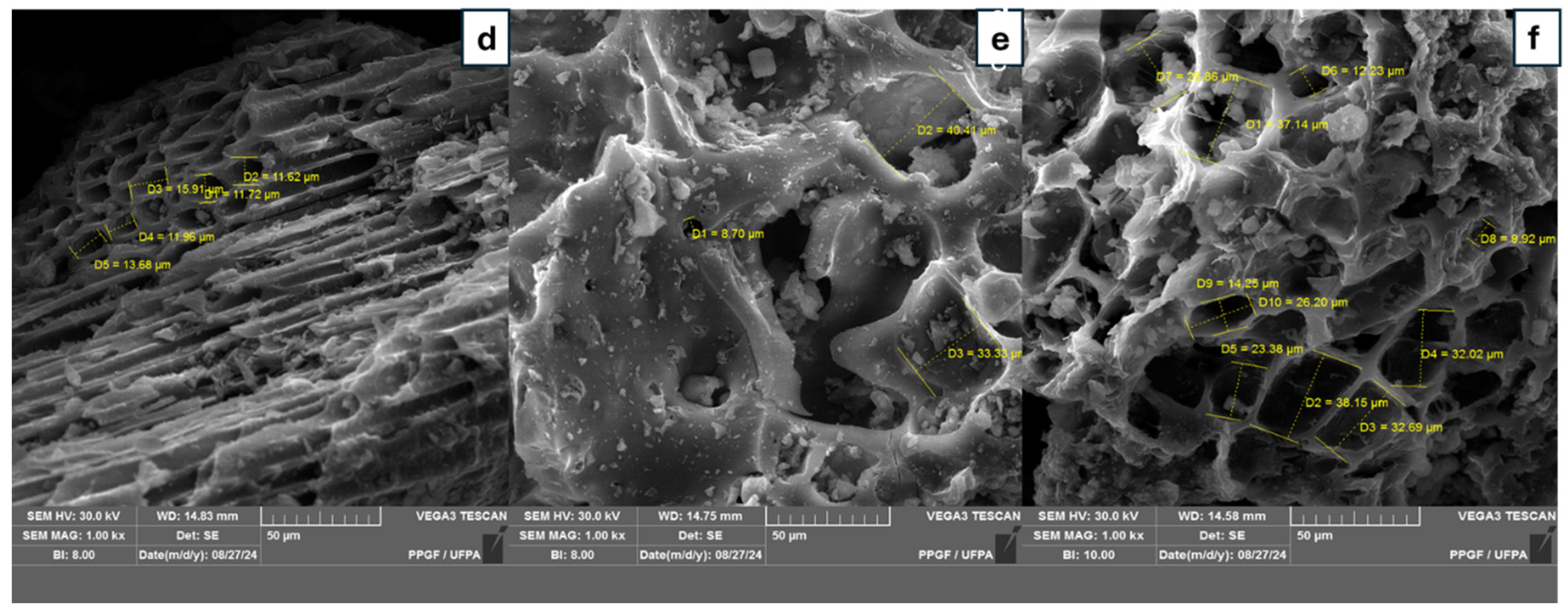
Figure 7.
SEM of biochar obtained by catalytic pyrolysis of the fraction (organic matter and paper) of MSW at 475°C 10.0% (wt.) Ca(OH)2 1.0 atmosphere (g) Region 1 (h) Region 2 (i) Region 3, with [MAG: 1.0 kx and 5.0 kx].
Figure 7.
SEM of biochar obtained by catalytic pyrolysis of the fraction (organic matter and paper) of MSW at 475°C 10.0% (wt.) Ca(OH)2 1.0 atmosphere (g) Region 1 (h) Region 2 (i) Region 3, with [MAG: 1.0 kx and 5.0 kx].
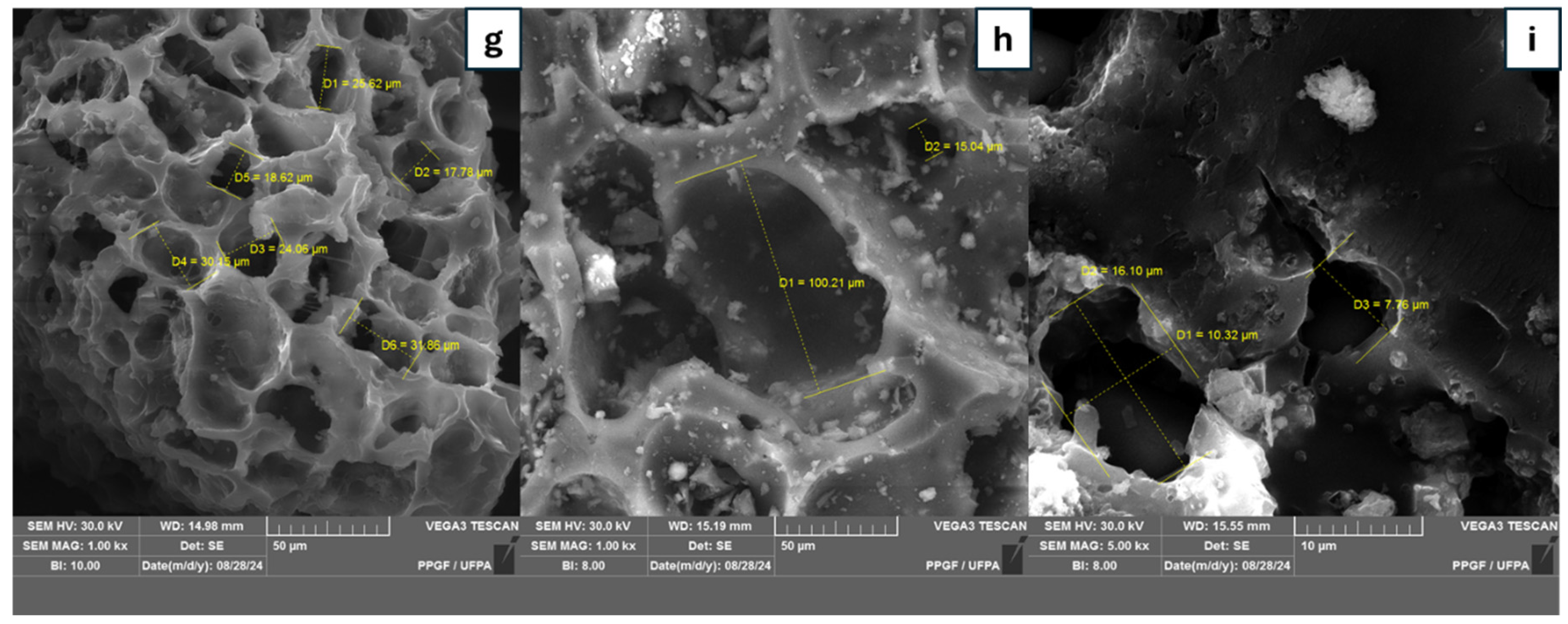
Figure 8.
Morphology of biochar obtained by thermal pyrolysis of the fraction (organic matter and paper) of MSW at 450°C (a) Region 1 and EDS results.
Figure 8.
Morphology of biochar obtained by thermal pyrolysis of the fraction (organic matter and paper) of MSW at 450°C (a) Region 1 and EDS results.
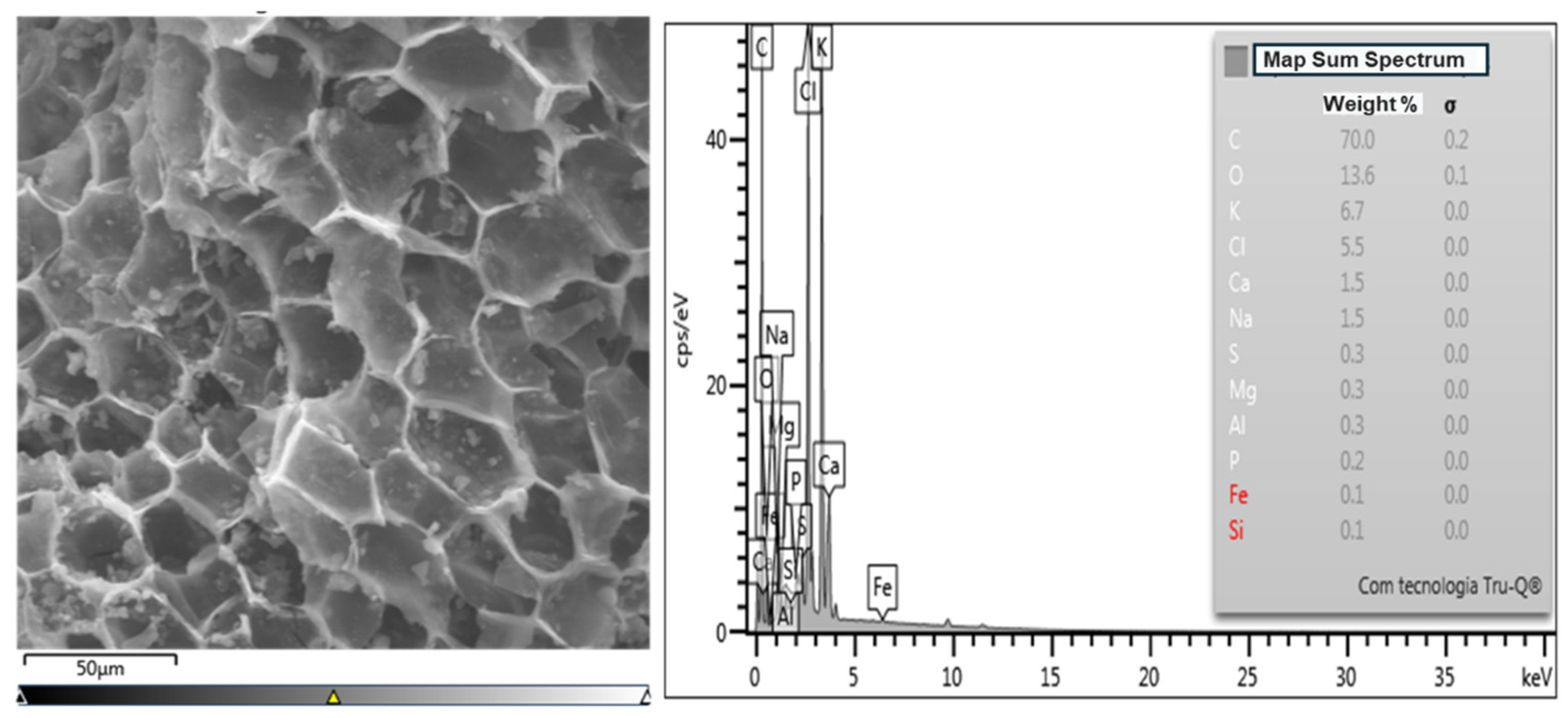
Figure 9.
XRD of solid phase products by pyrolysis of the fraction (organic matter and paper) of MSW at 450°C and 1.0 atmosphere, using a 125 mL borosilicate glass reactor, on a laboratory scale, in different socioeconomic regions.
Figure 9.
XRD of solid phase products by pyrolysis of the fraction (organic matter and paper) of MSW at 450°C and 1.0 atmosphere, using a 125 mL borosilicate glass reactor, on a laboratory scale, in different socioeconomic regions.
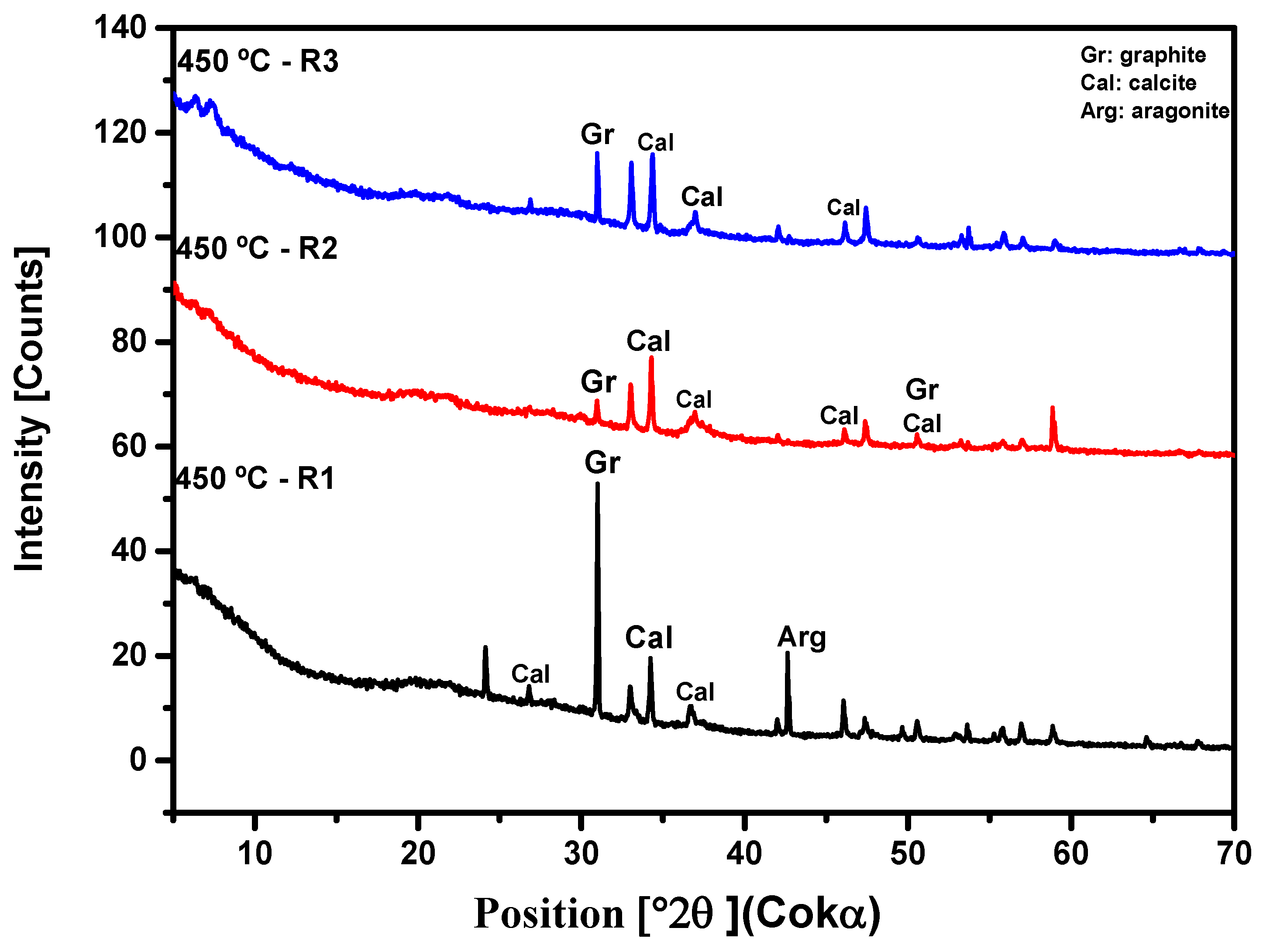
Figure 10.
XRD of solid phase products by pyrolysis of the fraction (organic matter and paper) of MSW at 400°C and 1.0 atmosphere, with 10% (by mass) of CaOH2 using a 125 mL borosilicate glass reactor, on a laboratory scale, in different socioeconomic regions.
Figure 10.
XRD of solid phase products by pyrolysis of the fraction (organic matter and paper) of MSW at 400°C and 1.0 atmosphere, with 10% (by mass) of CaOH2 using a 125 mL borosilicate glass reactor, on a laboratory scale, in different socioeconomic regions.
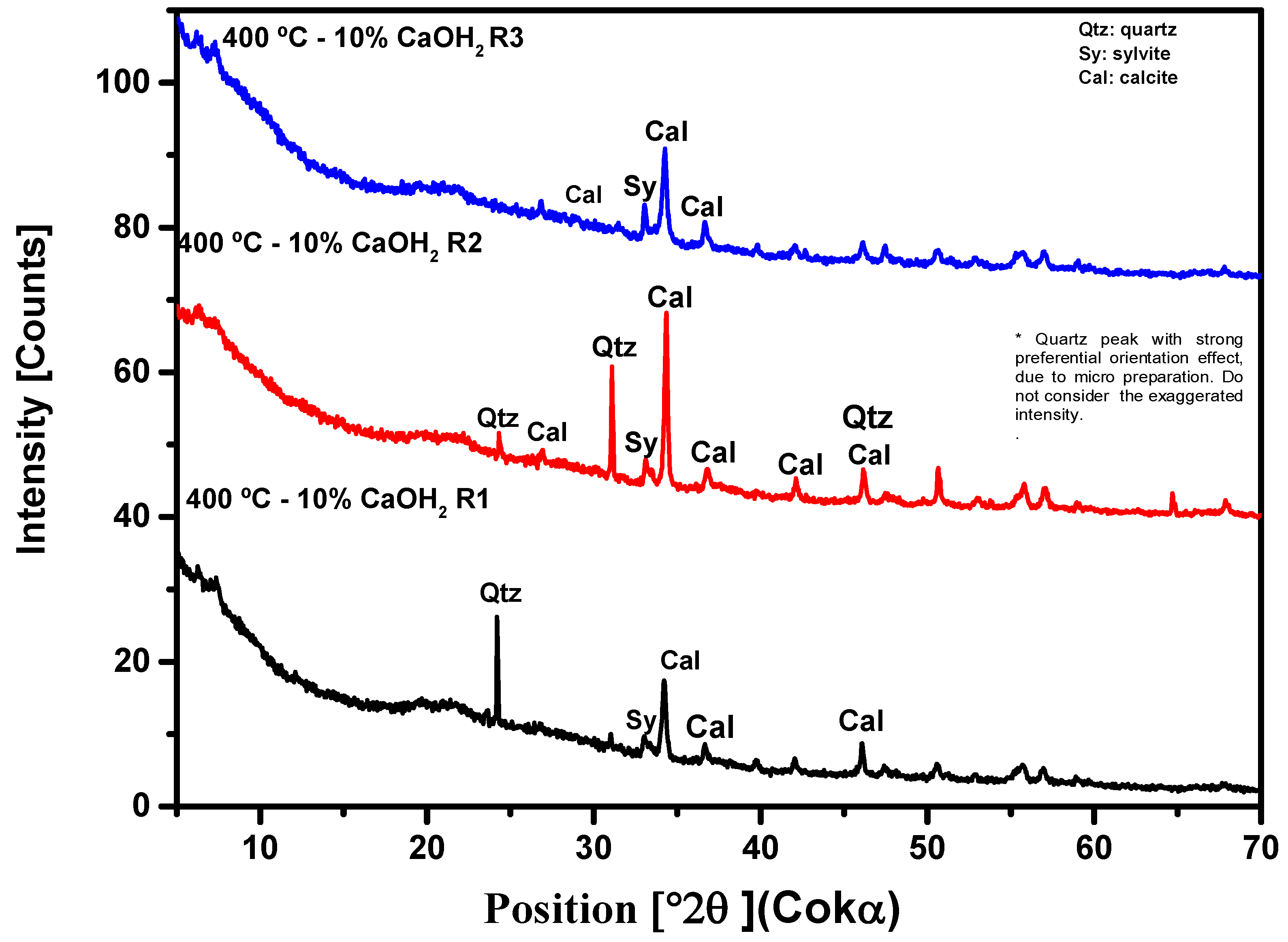
Figure 11.
XRD of solid phase products by pyrolysis of the fraction (organic matter and paper) of MSW at 475°C and 1.0 atmosphere, with 10% (by mass) of CaOH2 using a 125 mL borosilicate glass reactor, on a laboratory scale, in different socioeconomic regions.
Figure 11.
XRD of solid phase products by pyrolysis of the fraction (organic matter and paper) of MSW at 475°C and 1.0 atmosphere, with 10% (by mass) of CaOH2 using a 125 mL borosilicate glass reactor, on a laboratory scale, in different socioeconomic regions.
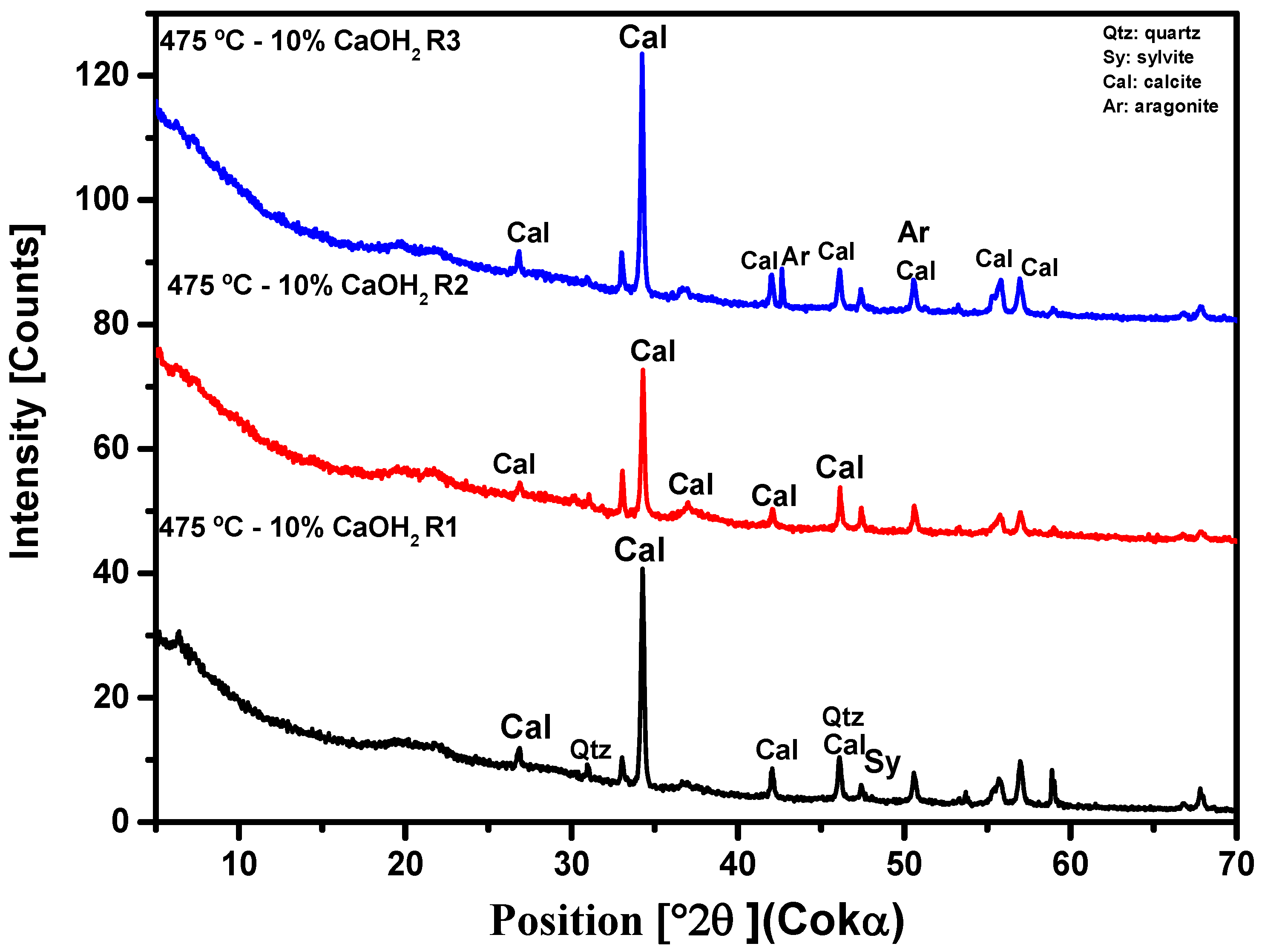
Figure 12.
Pyrolysis process formation products.
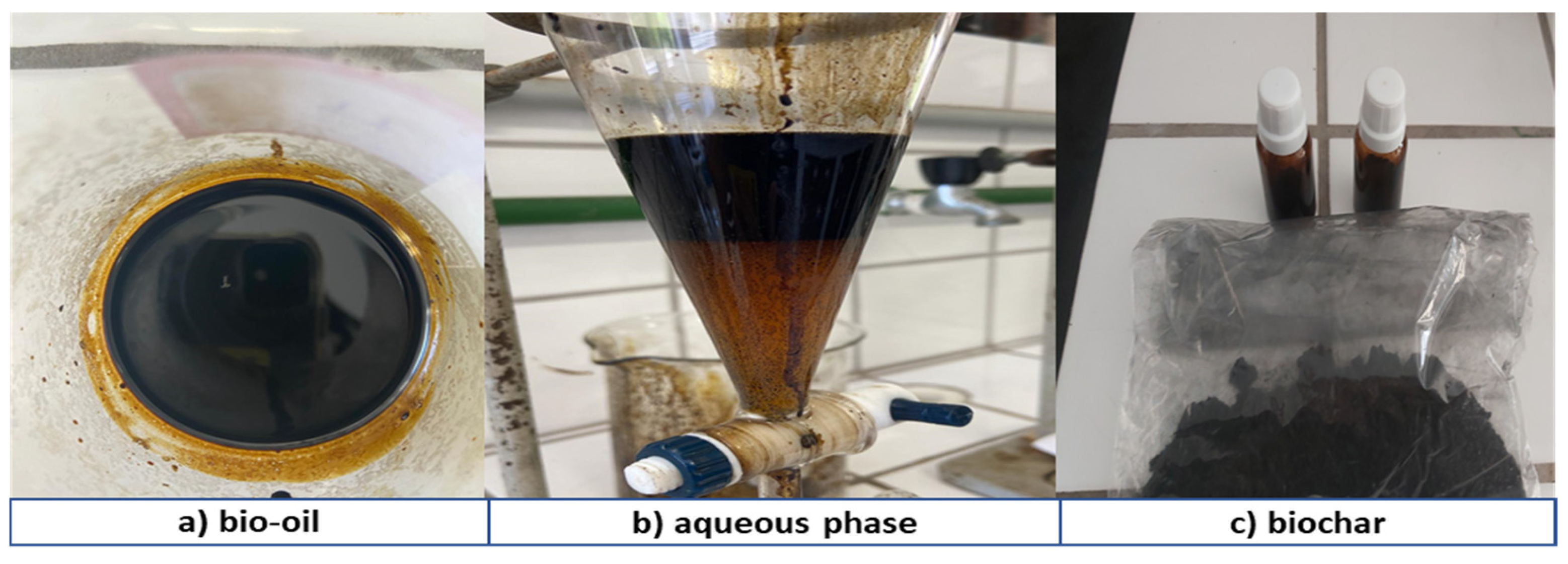
Figure 13.
Effect of pyrolysis temperature on the yields of reaction products (bio-oil, aqueous phase, biochar and gas) by pyrolysis of the MSW fraction (organic matter and paper).
Figure 13.
Effect of pyrolysis temperature on the yields of reaction products (bio-oil, aqueous phase, biochar and gas) by pyrolysis of the MSW fraction (organic matter and paper).
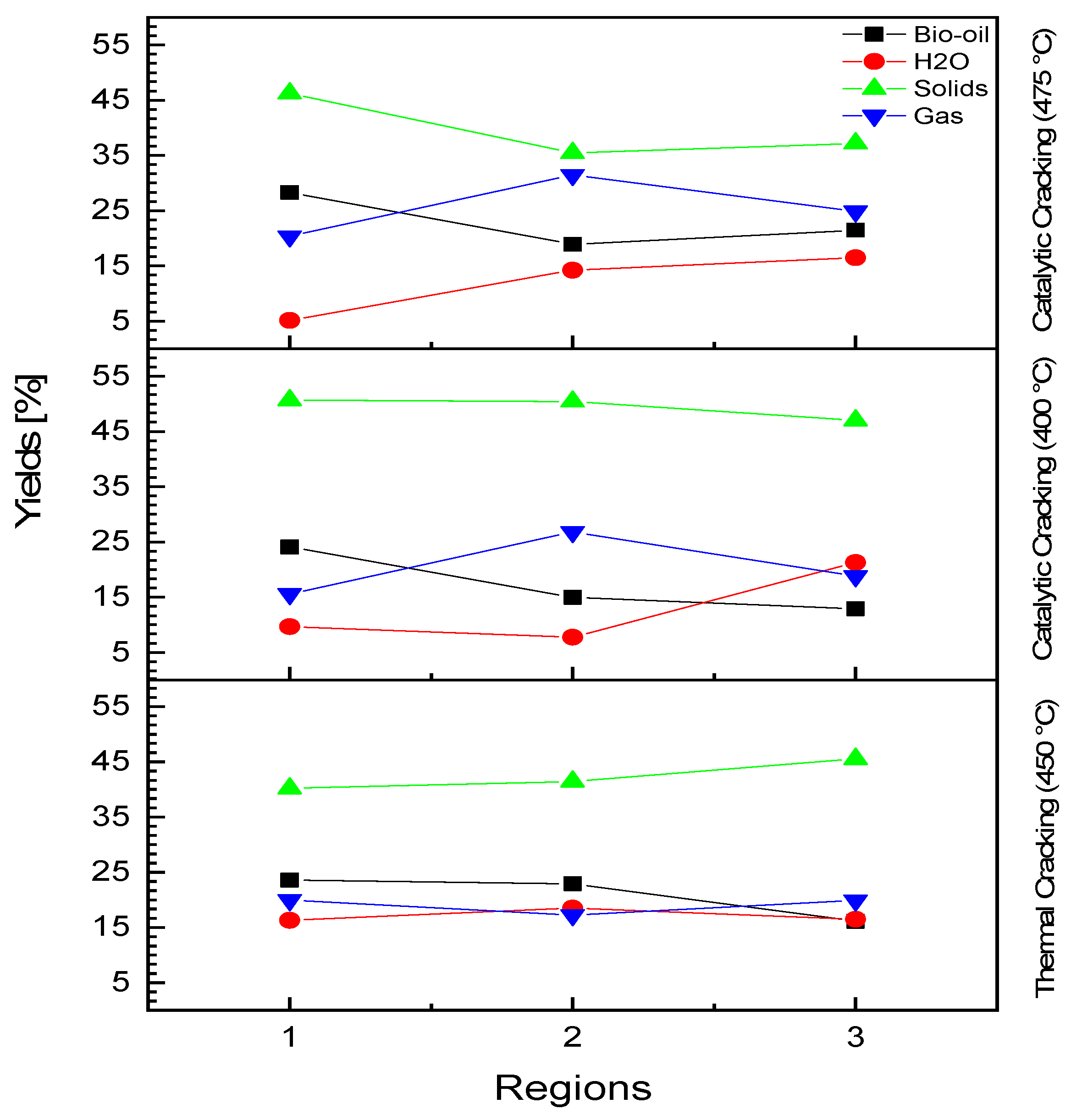
Figure 14.
FT-IR of bio-oil obtained by pyrolysis of the MSW fraction (organic matter and paper) at 450 °C and catalytic 10% (by mass) at 400 °C and 475 °C, 1.0 atmosphere, on laboratory scale, for Socioeconomic Region 1.
Figure 14.
FT-IR of bio-oil obtained by pyrolysis of the MSW fraction (organic matter and paper) at 450 °C and catalytic 10% (by mass) at 400 °C and 475 °C, 1.0 atmosphere, on laboratory scale, for Socioeconomic Region 1.
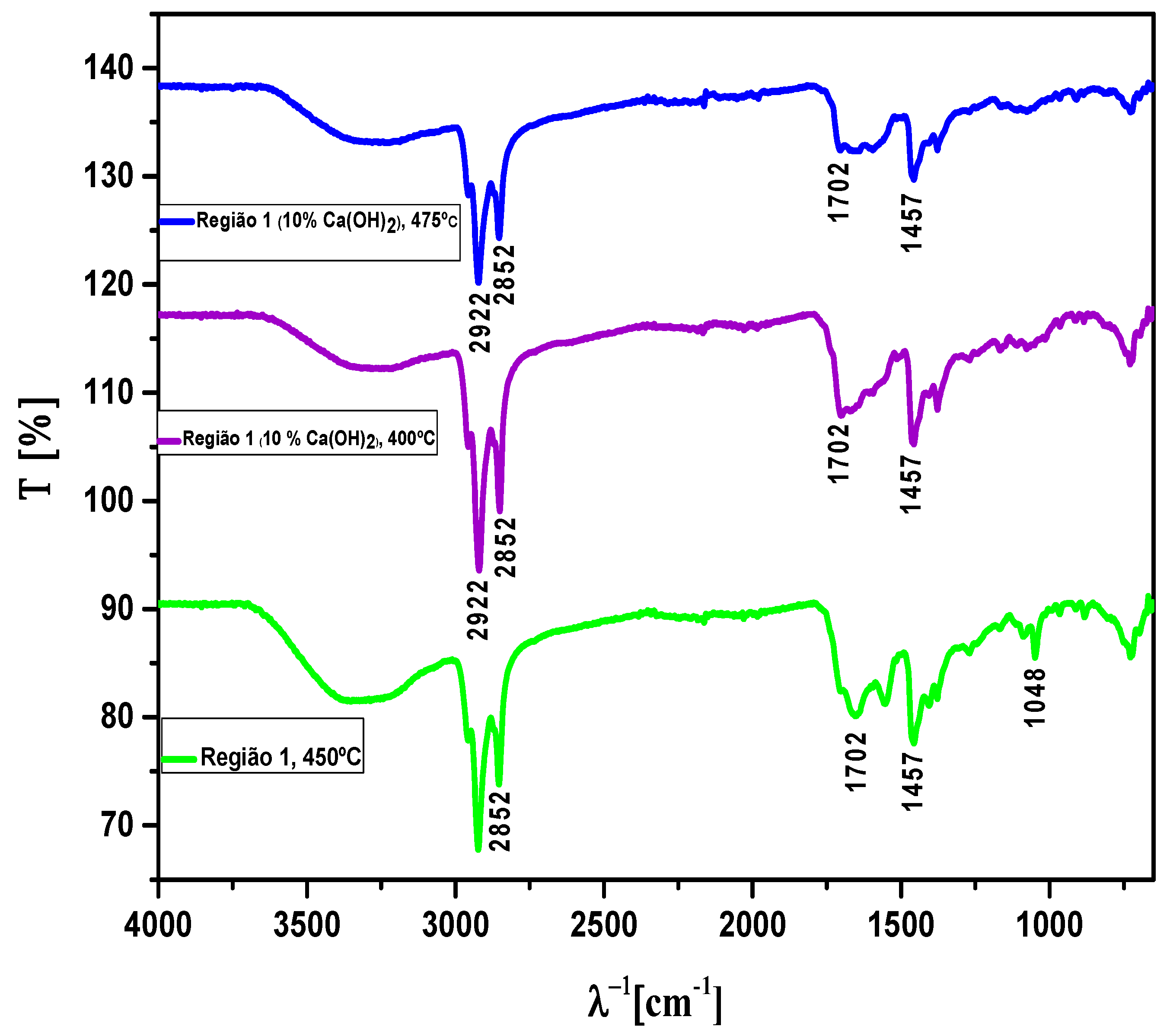
Figure 16.
Chemical composition, expressed in hydrocarbons, oxygenated and nitrogenous bio-oils obtained by thermal pyrolysis at 450°C and catalytic pyrolysis of the MSW fraction at 400 and 475°C, 1.0 atm, 10.0% (by mass ) of Ca(OH)2 on a laboratory scale.
Figure 16.
Chemical composition, expressed in hydrocarbons, oxygenated and nitrogenous bio-oils obtained by thermal pyrolysis at 450°C and catalytic pyrolysis of the MSW fraction at 400 and 475°C, 1.0 atm, 10.0% (by mass ) of Ca(OH)2 on a laboratory scale.
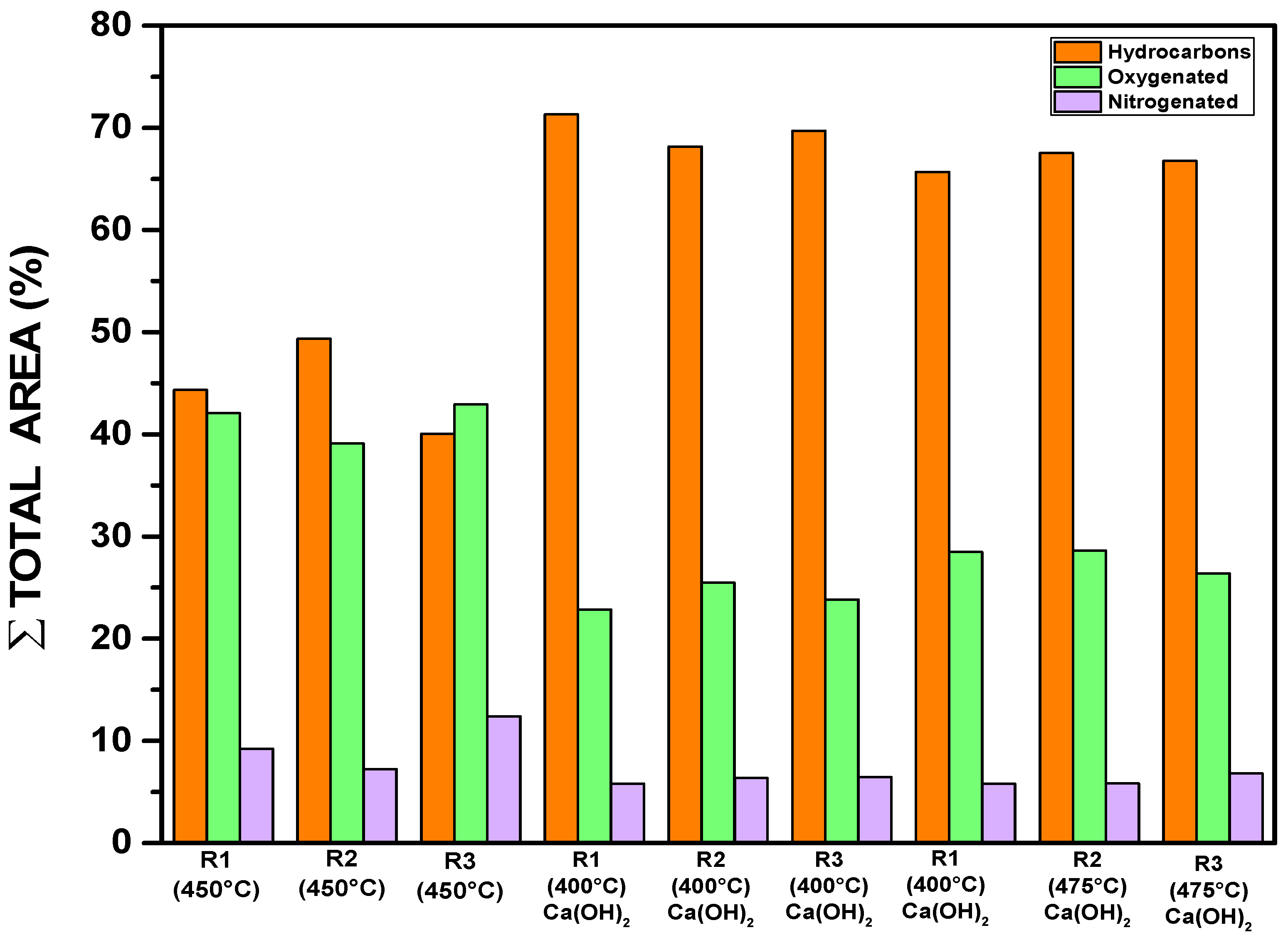
Table 1.
Socio-economic classification in the municipality of Belém-Pará-Brazil based on minimum salary [76].
Table 1.
Socio-economic classification in the municipality of Belém-Pará-Brazil based on minimum salary [76].
| Socio-economic Classification | |
|---|---|
| Classes | Family Income (Minimum/Basic Salary) |
| A | over 20 salaries |
| B | from 10 to 20 salaries |
| C | from 10 to 20 salaries |
| D | from 10 to 20 salaries |
| E | up to 02 salaries |
Table 2.
Determination of the grouping of sectors into regions.
| Region | Sectors | Neighborhoods |
| 1 | 1, 2 e 3 | Aurá, Águas Lindas, Curió-Utinga, Guanabara, Castanheira, Souza e Marco |
| 2 | 4,5 e 6 | Canudos, Terra Firme, Guamá, Condor, Jurunas e Fátima |
| 3 | 7,8 e 9 | Umarizal, São Brás, Cremação, Batista Campos, Nazaré, Reduto, Campina e Cidade Velha |
Table 3.
Thermal and catalytic pyrolysis experiments on the laboratory scale.
| Experiments | Material |
Catalyst mass Ca(OH)2 (%) | Temperature (°C) | Retention Time (min.) |
| Region 1 (1) | F.O + Paper | 0 | 450 | 1h 20 |
| Region 1 (2) | F. O+ Paper | 0 | 450 | 1h 20 |
| Region 1 (3) | F.O.+ Paper | 0 | 450 | 1h 20 |
| Region 2 (4) | F.O.+ Paper | 10 | 400 | 1h 20 |
| Region 2 (5) | F.O.+ Paper | 10 | 400 | 1h 20 |
| Region 2 (6) | F.O.+ Paper | 10 | 400 | 1h 20 |
| Region 3 (7) | F.O.+ Paper | 10 | 475 | 1h20 |
| Region 3 (8) | F.O.+ Paper | 10 | 475 | 1h20 |
| Region 3 (9) | F.O.+ Paper | 10 | 475 | 1h20 |
Legend*: F.O.: organic fraction.
Table 4.
Mass percentages and atomic mass of biochars obtained by pyrolysis of the fraction (organic matter and paper) of MSW at 450 °C, 1.0 atmosphere on laboratory scale.
Table 4.
Mass percentages and atomic mass of biochars obtained by pyrolysis of the fraction (organic matter and paper) of MSW at 450 °C, 1.0 atmosphere on laboratory scale.
| Pirolysis | ||||||
| Chemical Elements |
(R1) 450°C |
(R2) 450°C |
(R3) 450°C |
|||
| Mass [wt.%] |
SD | Mass [wt.%] |
SD | Mass [wt.%] |
SD | |
| C | 70.0 | 0.2 | 60.4 | 0.1 | 62.0 | 0.2 |
| O | 13.6 | 0.1 | 26.3 | 0.1 | 22.2 | 0.2 |
| K | 6.7 | 0.0 | 1.6 | 0.0 | 2.5 | 0.0 |
| Cl | 5.5 | 0.0 | 1.6 | 0.0 | 3.0 | 0.0 |
| Ca | 1.5 | 0.0 | 8.4 | 0.0 | 7.2 | 0.0 |
| Na | 1.5 | 0.0 | 1.5 | 0.0 | 1.6 | 0.0 |
| S | 0.3 | 0.0 | - | - | - | 0.0 |
| Mg | 0.3 | 0.0 | 0.3 | 0.0 | 0.3 | 0.0 |
| Al | 0.3 | 0.0 | 0.1 | 0.0 | 0.1 | 0.0 |
| P | 0.2 | 0.0 | 0.2 | 0.0 | 0.4 | 0.0 |
| Fe | 0.1 | 0.0 | 0.1 | 0.0 | 0.1 | 0.0 |
| Si | 0.1 | 0.0 | - | - | 0.5 | 0.0 |
| Cu | - | - | - | - | 0.1 | 0.0 |
SD= Standard Deviation.
Table 5.
Percentages by mass and atomic mass of biochars obtained by catalytic pyrolysis of the fraction (organic matter and paper) of MSW at 400 °C, 1.0 atmosphere, with 10.0% (by mass) of Ca(OH)2 as catalyst, on a laboratory scale.
Table 5.
Percentages by mass and atomic mass of biochars obtained by catalytic pyrolysis of the fraction (organic matter and paper) of MSW at 400 °C, 1.0 atmosphere, with 10.0% (by mass) of Ca(OH)2 as catalyst, on a laboratory scale.
| Pirolysis | ||||||
| Chemical Elements |
(R1) 400°C |
(R2) 400°C |
(R3) 400°C |
|||
| Mass [wt.%] |
SD | Mass [wt.%] |
SD | Mass [wt.%] |
SD | |
| C | 62.5 | 0.1 | 60.5 | 0.1 | 56.7 | 0.1 |
| O | 18.9 | 0.1 | 24.5 | 0.1 | 28.8 | 0.1 |
| K | 2.9 | 0.0 | 2.4 | 0.0 | 1.1 | 0.0 |
| Cl | 4.1 | 0.0 | 3.4 | 0.0 | 1.1 | 0.0 |
| Ca | 6.8 | 0.0 | 6.2 | 0.0 | 9.5 | 0.0 |
| Na | 2.3 | 0.0 | 2.3 | 0.0 | 1.4 | 0.0 |
| S | 0.2 | 0.0 | - | 0.0 | - | 0.0 |
| Mg | 0.4 | 0.0 | 0.2 | 0.0 | 0.2 | 0.0 |
| Al | 0.2 | 0.0 | - | 0.0 | 0.6 | 0.0 |
| P | 0.6 | 0.0 | - | 0.0 | 0.3 | 0.0 |
| Fe | 0.7 | 0.0 | 0.4 | 0.0 | - | 0.0 |
| Si | 0.4 | 0.0 | - | 0.0 | 0.2 | 0.0 |
SD= Standard Deviation.
Table 6.
Percentages by mass and atomic mass of biochars obtained by catalytic pyrolysis of the fraction (organic matter and paper) of MSW at 475 °C, 1.0 atmosphere, with 10.0% (by mass) of Ca(OH)2 as catalyst, on a laboratory scale.
Table 6.
Percentages by mass and atomic mass of biochars obtained by catalytic pyrolysis of the fraction (organic matter and paper) of MSW at 475 °C, 1.0 atmosphere, with 10.0% (by mass) of Ca(OH)2 as catalyst, on a laboratory scale.
| Pirolysis | ||||||
| Chemical Elements |
(R1) 475°C |
(R2) 475°C |
(R3) 475°C |
|||
| Mass [wt.%] |
SD | Mass [wt.%] |
SD | Mass [wt.%] |
SD | |
| C | 77.6 | 0.1 | 70.4 | 0.1 | 45.0 | 0.1 |
| O | 18.2 | 0.1 | 19.6 | 0.1 | 32.4 | 0.1 |
| K | 1.5 | 0.0 | 1.7 | 0.0 | 2.6 | 0.0 |
| Cl | 0.5 | 0.0 | 1.7 | 0.0 | 2.6 | 0.0 |
| Ca | 0.8 | 0.0 | 1.3 | 0.0 | 14.2 | 0.0 |
| Na | 0.9 | 0.0 | 1.2 | 0.0 | 1.5 | 0.0 |
| S | - | - | - | - | 0.1 | 0.0 |
| Mg | 0.4 | 0.0 | 0.1 | 0.0 | 0.4 | 0.0 |
| Al | - | - | - | - | 0.1 | 0.0 |
| P | - | - | 0.2 | 0.0 | 0.5 | 0.0 |
| Fe | 0.1 | 0.0 | - | - | 0.4 | 0.0 |
| Si | - | - | 0.1 | 0.0 | 0.2 | 0.0 |
| Cu | - | - | 0.1 | 0.0 | 0.1 | 0.0 |
SD= Standard Deviation.
Table 7.
Process parameters, mass balances, and yields of reaction products (liquids, solids, H2O, and gas) by pyrolysis of MSW fraction (organic matter and paper) at 450 °C, 1.0 atmosphere, in laboratory scale for socioeconomic regions.
Table 7.
Process parameters, mass balances, and yields of reaction products (liquids, solids, H2O, and gas) by pyrolysis of MSW fraction (organic matter and paper) at 450 °C, 1.0 atmosphere, in laboratory scale for socioeconomic regions.
| Process parameters | Region 1 | Region 2 | Region 3 |
| 450 [°C] | 450 [°C] | 450 [°C] | |
| 0.0 (wt.) |
0.0 (wt.) |
0.0 (wt.) |
|
| Mass of urban solid wastes [g] | 40.1 | 40.11 | 40.57 |
| Cracking time [min] | 20 | 20 | 20 |
| Initial cracking temperature [°C] | 334 | 363 | 364 |
| Mass of solids (coke) [g] | 16.11 | 16.61 | 19.28 |
| Mass of bio-oil [g] | 9.45 | 9.19 | 6.54 |
| Mass of H2O [g] | 6.54 | 7.42 | 6.68 |
| Mass of gas [g] | 8.00 | 6.89 | 8.07 |
| Yield of bio-oil [%] | 23.57 | 22.91 | 16.12 |
| Yield of H2O [%] | 16.31 | 18.49 | 16.46 |
| Yield of solids [%] | 40.17 | 41.41 | 45.52 |
| Yield of gas [%] | 19.95 | 17.21 | 19.89 |
Table 8.
Process parameters, mass balances, and yields of reaction products (liquids, solids, H2O, and gas) by pyrolysis and catalytic cracking of urban solid wastes (organic matter and paper) at 400 °C, 1.0 atm, 10.0% (wt.) of Ca(OH)2, in laboratory scale.
Table 8.
Process parameters, mass balances, and yields of reaction products (liquids, solids, H2O, and gas) by pyrolysis and catalytic cracking of urban solid wastes (organic matter and paper) at 400 °C, 1.0 atm, 10.0% (wt.) of Ca(OH)2, in laboratory scale.
| Process parameters | Region 1 | Region 2 | Region 3 |
| 400 [°C] | 400 [°C] | 400 [°C] | |
| 10.0 (wt.) |
10.0 (wt.) |
10.0 (wt.) |
|
| Mass of urban solid wastes [g] | 30.0 | 30.0 | 30.03 |
| Mass of Ca(OH)2 [g] | 3.0 | 3.0 | 3.0 |
| Cracking time [min] | 20 | 20 | 20 |
| Initial cracking temperature [°C] | 351 | 327 | 328 |
| Mass of solids (coke) [g] | 15.2 | 15.13 | 14.12 |
| Mass of bio-oil [g] | 7.23 | 4.49 | 3.88 |
| Mass of H2O [g] | 2.90 | 2.33 | 6.39 |
| Mass of gas [g] | 4.67 | 8.05 | 5.65 |
| Yield of bio-oil [%] | 24.10 | 14.97 | 12.92 |
| Yield of H2O [%] | 9.66 | 7.77 | 21.27 |
| Yield of solids [%] | 50.67 | 50.43 | 47.01 |
| Yield of gas [%] | 15.57 | 26.83 | 18.81 |
Table 9.
Process parameters, mass balances, and yields of reaction products (liquids, solids, H2O, and gas) by pyrolysis and catalytic cracking of urban solid wastes (organic matter and paper) at 475 °C, 1.0 atm, 10.0% (wt.) of Ca(OH)2, in laboratory scale.
Table 9.
Process parameters, mass balances, and yields of reaction products (liquids, solids, H2O, and gas) by pyrolysis and catalytic cracking of urban solid wastes (organic matter and paper) at 475 °C, 1.0 atm, 10.0% (wt.) of Ca(OH)2, in laboratory scale.
| Process parameters | Region 1 | Region 2 | Region 3 |
| 475 [°C] | 475 [°C] | 475 [°C] | |
| 10.0 (wt.) |
10.0 (wt.) |
10.0 (wt.) |
|
| Mass of urban solid wastes [g] | 30.0 | 30.08 | 30.06 |
| Mass of Ca(OH)2 [g] | 3.0 | 3.02 | 3.00 |
| Cracking time [min] | 20 | 20 | 20 |
| Initial cracking temperature [°C] | 364 | 381 | 340 |
| Mass of solids (coke) [g] | 13.87 | 10.66 | 11.18 |
| Mass of bio-oil [g] | 8.48 | 5.68 | 6.45 |
| Mass of H2O [g] | 1.53 | 4.28 | 4.95 |
| Mass of gas [g] | 6.10 | 9.47 | 7.48 |
| Yield of bio-oil [%] | 28.28 | 18.88 | 21.45 |
| Yield of H2O [%] | 5.11 | 14.22 | 16.46 |
| Yield of solids [%] | 46.24 | 35.43 | 37.19 |
| Yield of gas [%] | 20.35 | 31.48 | 24.88 |
Table 10.
Effect of temperature on the acid index of bio-oils and aqueous phase obtained by thermal pyrolysis at 450°C and catalytic pyrolysis of the MSW fraction at 400 and 475°C, 1.0 atm, 10.0% (by mass) of Ca (OH)2 on a laboratory scale.
Table 10.
Effect of temperature on the acid index of bio-oils and aqueous phase obtained by thermal pyrolysis at 450°C and catalytic pyrolysis of the MSW fraction at 400 and 475°C, 1.0 atm, 10.0% (by mass) of Ca (OH)2 on a laboratory scale.
| Physicochemical Property | Temperature | |||||||||
|---|---|---|---|---|---|---|---|---|---|---|
| R1 | R2 | R3 | R1 | R2 | R3 | R1 | R2 | R3 | ||
| Acid Index | 450 °C | 450 °C | 450 °C | 400°C Ca(OH)2 |
400°C Ca(OH)2 |
400°C Ca(OH)2 | 475°C Ca(OH)2 |
475°C Ca(OH)2 |
475°C Ca(OH)2 |
|
| I.ABio-Oil [mg KOH/g] |
116.8 | 115.1 | 115.3 | 34.45 | 34.41 | 40.0 | 36.36 | 36.31 | 37.20 | |
| I.AAqueous Phase [mg KOH/g] | 69.01 | 65.55 | 76.23 | 42.3 | 42.1 | 42.0 | 43.4 | 4.2 | 40.0 | |
Table 11.
Effect of temperature on the chemical composition, expressed in hydrocarbons, oxygenated and nitrogenated, of bio-oils obtained by thermal pyrolysis at 450°C and catalytic pyrolysis of the MSW fraction at 400 and 475°C, 1.0 atm , 10.0% (by mass) Ca(OH)2 on laboratory scale.
Table 11.
Effect of temperature on the chemical composition, expressed in hydrocarbons, oxygenated and nitrogenated, of bio-oils obtained by thermal pyrolysis at 450°C and catalytic pyrolysis of the MSW fraction at 400 and 475°C, 1.0 atm , 10.0% (by mass) Ca(OH)2 on laboratory scale.
| Temperature [°C] | Concentration [%area.] | |||
|---|---|---|---|---|
| Hydrocarbons | Oxygenated | Nitrogenated | Chlorinated | |
| 450 (R1) | 44.34 | 42.09 | 9.23 | 4.34 |
| 450 (R2) | 49.34 | 39.09 | 7.23 | 4.34 |
| 450 (R3) | 40.07 | 42.91 | 12.40 | 4.34 |
| 400 (R1) | 71.32 | 22.85 | 5.82 | - |
| 400 (R2) | 68.16 | 25.48 | 6.36 | - |
| 400 (R3) | 69.70 | 23.83 | 6.47 | - |
| 475 (R1) | 65.69 | 28.48 | 5.82 | - |
| 475 (R2) | 67.53 | 28.63 | 5.84 | - |
| 475 (R3) | 66.77 | 26.40 | 6.82 | - |
Disclaimer/Publisher’s Note: The statements, opinions and data contained in all publications are solely those of the individual author(s) and contributor(s) and not of MDPI and/or the editor(s). MDPI and/or the editor(s) disclaim responsibility for any injury to people or property resulting from any ideas, methods, instructions or products referred to in the content. |
© 2024 by the authors. Licensee MDPI, Basel, Switzerland. This article is an open access article distributed under the terms and conditions of the Creative Commons Attribution (CC BY) license (http://creativecommons.org/licenses/by/4.0/).
Copyright: This open access article is published under a Creative Commons CC BY 4.0 license, which permit the free download, distribution, and reuse, provided that the author and preprint are cited in any reuse.
Alerts
MDPI Initiatives
Important Links
© 2025 MDPI (Basel, Switzerland) unless otherwise stated





